















SEPTEMBER / OCTOBER 2023 R39.90 (incl VAT) International R44.50 (excl tax) SADC’s rare earths revival JA Engineering’s Team (from left): Mbulelo Nkasana, Business Development, Sales & Marketing Director Matimba Mahange, CEO Rachel Babie, Supply Chain, Procurement & Logistics Director 70%: phosphates imported into SA 20 000t p/a: Kinusi copper production JA ENGINEERING Meeting mining equipment demands MIN NG READ WHAT REALLY GOES DOWN IN SADC SA www.samining.co.za INSIDE: Phosphate mining and sustainability



IN BRIEF

6 Unlocking the full potential of robotic applications with high-performance abrasives.

FEATURES
14 Should we legalise zama zamas?


It has been suggested that zama zamas should be viewed as artisanal miners, something that could result in a boost to SA’s economy.
19 Tracing value by minimising mining waste
Taking a look at how gold mining companies can scramble through waste to track hidden value in raw gold hiding in those rocks initially declared waste.
22 SADC’s rare earths revival
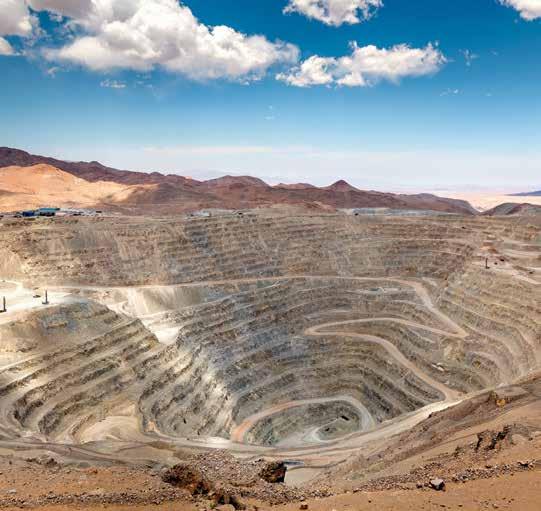
Looking into three key projects focusing on producing/ exporting commodities such as lithium, tantalum, graphite, cobalt, rare earths, copper and nickel.
25 Joburg Indaba
The Joburg Indaba is here, and will feature topics such as geopolitical and macro-economic developments, ESG considerations, energy security, and decarbonisation e orts.
28 Can phosphate mining be done sustainably?

Considering the e orts mines should make to minimise the ecological damage of phosphate mining, and ensure the industry remains sustainable.
22 20 000t p/a: Kinusi copper production

28 70%: phosphates imported into SA







REGULARS
4 Out of Africa
Business Spotlight – Enaex Africa’s plans to embrace artificial intelligence






Gary Alfonso speaks to CEO of Enaex Africa, Francisco Baudrand, about the company’s plans to embrace artificial intelligence, while also looking into incorporating sustainability within the organisation’s strategic objective.
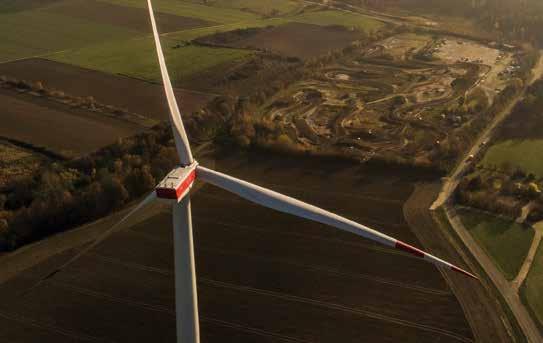
https://youtu.be/2U0RMa_6bko


www.samining.co.za or www.businessmediamags.co.za




www.linkedin.com/company/samining/ businessmediamags.co.za/mining/sa-mining/subscribe/







www.facebook.com/businessmediaMAGS/company/samining/


CONTENTS SEPTEMBER / OCTOBER 2023 14
SEPTEMBER OCTOBER 2023 R39.90 (incl VAT) International R44.50 (excl tax) SADC’s rare earths revival JA Engineering’s Team (from left): Mbulelo Nkasana, Business Development, Sales & Marketing Director Matimba Mahange, CEO Rachel Babie, Supply Chain, Procurement & Logistics Director 70%: phosphates imported into SA 20 000t p/a: Kinusi copper production JA ENGINEERING Meeting mining equipment demands MIN NG READ WHAT REALLY GOES DOWN IN SADC SA www.samining.co.za INSIDE: Phosphate mining and sustainability COVER STORY: PAGE 8 Local design and manufacture of OEM mining equipment and a er-market parts helps JA Engineering meet the demands of underground and opencast mines.
New approaches to the zama zama challenge.
NEWS IN NUMBERS
twitter.com/BMMagazines
19 22
rare earths
Optimising value by minimising mining waste. WATCH:
www.instagram.com/business_media_mags/
SADC’s
revival.
IN CASE YOU MISSED OUR INTERVIEW!
SCAN HERE
FROM ZAMA ZAMAS TO SUSTAINABILITY
Rodney Weidemann
Illegal artisanal miners – or zama zamas – have been in the news recently due to the impacts of their activities. Although their impacts are diverse and virtually all negative, the Artisanal and Small-Scale Mining Policy 2022 seeks to change this.
It has been suggested that zama zamas should be seen as artisanal miners, and that established mining companies should seek to work with the zama zamas by making them part of their operations, thereby bringing them into the formal economy. While there are many challenges with this proposal, it could conceivably result in a significant increase in the contribution of the junior mining sector to the South African economy.
Elsewhere, Marula Mining, a battery metals investment and exploration company, has three key projects under way in the Southern African Development Community region. All are focused on producing and exporting high-value commodities such as lithium, tantalum, graphite, cobalt, rare earths, copper and nickel – essential minerals of strategic importance to modern technologies and the global economy.
These projects – Blesberg Lithium and Tantalum Mine in South Africa, Nkombwa Hill Project in Zambia, and Kinusi Copper Mine in Tanzania – are expected to not only have a significant impact on the renewable energy sector, but a positive impact on the communities surrounding these projects.
We are aware that one of the inherent contributing factors in excessive mineral loss through waste is due to outdated mineral testing methods of the materials extracted during the mining process. In this issue, we take a look at how gold mining companies can scramble through waste to track hidden value in raw gold hiding in those rocks initially declared waste.
Although phosphate mining is considered essential for global agriculture and the role it plays
in food security, it is a mineral extraction process that can easily cause massive environmental damage. We take a look at the methods being used to make this more sustainable. From the responsible management of water resources to reducing chemical usage and developing cleaner extraction and processing technologies, we look at the various e orts being made to make phosphate mining safer and more environmentally friendly. Ensuring miners in remote areas have access to fresh water is critical, and we consider how this is achieved and why it is of such crucial importance. In addition, we look more deeply into the complex and at times risky challenges faced when undertaking sha sinking.
In a unique case study, we look at how Mammoet recently conducted the move of a several hundred tonne face shovel excavator between Kromdraai and Emalahleni – dealing with infrastructure challenges like fragile road surfaces and potholes.
EDITOR
Rodney Weidemann

Tel: 062 447 7803
Email: rodneyw@samining.co.za
ONLINE EDITOR
Stacey Visser
Email: vissers@businessmediamags.co.za


ART DIRECTOR
Shailendra Bhagwandin
Tel: 011 280 5946
Email: bhagwandinsh@arena.africa
ADVERTISING CONSULTANTS
Ilonka Moolman
Tel: 011 280 3120
Email: moolmani@samining.co.za
Tshepo Monyamane
Tel: 011 280 3110
Email: tshepom@samining.co.za
PRODUCTION CO-ORDINATOR

Neesha Klaaste
Tel: 011 280 5063
Email: neeshak@sahomeowner.co.za
SUB-EDITOR
Andrea Bryce
BUSINESS MANAGER
Claire Morgan
Tel: 011 280 5783
Email: morganc@sahomeowner.co.za

GENERAL MANAGER MAGAZINES
Jocelyne Bayer
SWITCHBOARD
Tel: 011 280 3000
SUBSCRIPTIONS
Neesha Klaaste
Tel: 011 280 5063
Email: neeshak@sahomeowner.co.za
energy supply security, and
The Joburg Indaba is around the corner once again, and the upcoming event will feature topics such as geopolitical and macro-economic developments, collaboration between industry and government, the energy transition and its critical metals and minerals, and innovation and digital transformation. Highlights will also include a focus on environmental, social and corporate governance considerations, energy supply security, and decarbonisation e orts within mining operations.

Finally, in our cover story, we talk to JA Engineering – now in its fourth decade of operations – to find out how its local design and manufacture of OEM mining equipment and a er-market parts, as well as its strong refurbishment capabilities, meet the varied demands of underground and opencast mines.
Gary Alfonso speaks to CEO of Enaex Africa, Francisco Baudrand, about the company’s plans to embrace artificial intelligence, while also looking into incorporating sustainability within the organisation’s strategic objective. https://youtu.be/2U0RMa_6bko
PRINTING
CTP Printers, Cape Town
PUBLISHER

Arena Holdings (Pty) Ltd, PO Box 1746, Saxonwold, 2132

Copyright Arena Holdings (Pty) Ltd. No part of this publication may be reproduced, stored in a retrieval system or transmitted in any form or by any means, electronic or mechanical, without prior written permission. Arena Holdings (Pty) Ltd is not responsible for the views of its contributors.

www.samining.co.za 2 SA MINING SEPTEMBER / OCTOBER 2023 FROM THE EDITOR
NG READ WHAT REALLY GOES DOWN IN SADC SA www.samining.co.za
MIN
WATCH: Business Spotlight – Enaex Africa’s plans to embrace artificial intelligence IN CASE YOU MISSED OUR INTERVIEW!





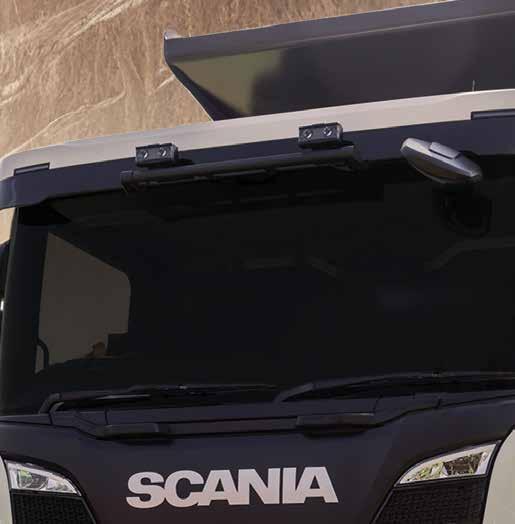
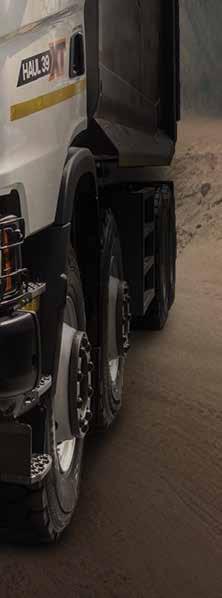

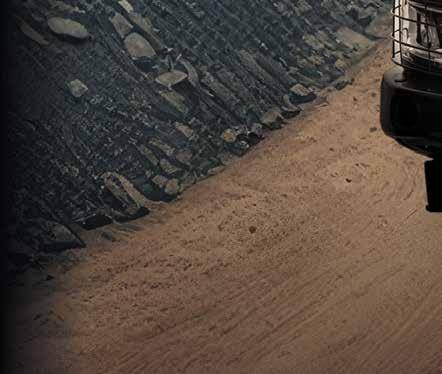










Efficient mining. Fleet and Driver Services Workshop Services Finance and Services Haul 39 For more information contact us on: 087 286 6707 zaMarketing.Communications@scania.com Time for smarter solutions. With our extensive Lean Production experience, tailored mining solutions, we’ll give you everything you need to optimise your production flow and drive efficiencies across your chain. Together with the world’s most sustainable transport fleet and an industry-leading total cost of ownership, we can cut your emissions like no one else can. The future of safe, productive, and sustainable mining operations begins with Scania.
AfCFTA






A DRIVING FORCE FOR TRANSPORT AND LOGISTICS IN AFRICA



The African Continental Free Trade Area (AfCFTA) envisions a borderless Africa, removing barriers to trade and investment by eliminating tari s on most goods, harmonising customs procedures, encouraging entrepreneurship and foreign investment, and promoting the free movement of people and capital.
From e icient road networks and modern rail systems to well-performing port facilities and streamlined air transportation, transport and logistics are the catalyst for sustainable, cross-border exchange and economic development, and have a pivotal role to play in the success of the AfCFTA.
During a recent online panel discussion involving key players in the AfCFTA talks, various challenges and opportunities were placed high on the agenda and will be unpacked at various trade shows during this year.
Beatrice Chaytor, head of Division –Trade in Services of the AfCFTA Secretariat in Ghana, believes once the free trade agreement is fully implemented, tra ic routes across air, ports, rail and road travel will improve.
“There are significant opportunities for investors in vital infrastructure like airports, warehousing, cold storage and more, and with tourism on the continent back to 88% of pre-pandemic levels for the first quarter

of the year, ensuring a robust and reliable transport and logistics system across the continent makes good business sense.”
She says 46 out of 54 African countries have signed the AfCFTA, and governments now need to embrace this commitment and regulations must follow. Transport and logistics will be prioritised to be “liberalised” under the AfCFTA, with developments expected in the coming months.
improved transport and logistics will boost job creation and reduce poverty, among other benefits.
“Accessibility, connectivity, productivity, capacity and predictability matter. The faster people can move around, the more the African economy can progress,” he says. He suggests that breaking down silos in government and working together will drive greater progress. “This is because digitisation is also important to boost global access.”
Bowale Odumade, VP at Africa Finance Corporation, agrees, as nearly 30% of African countries are landlocked, so “we need to remove cross-border constraints. All stakeholders must come together for the common good.”
In particular, she highlights the challenges in successfully financing African infrastructure projects, due to the current costly and lengthy processes involved.
John Bosco Kalisa, an economist and East African Business Council (EABC) executive director, agrees that transport and logistics are enablers of the AfCFTA, and says intraAfrica trade is currently at 17%. “Intracontinental trade in Africa could reach 81% by 2035,” he says.

Furthermore, notes Andrew Othieno from Uganda’s Prime Minister’s Delivery Unit,


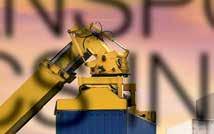



The panellists further agreed that without partnerships and the private sector’s support, it would be di icult to take infrastructure projects forward. Dr Christian Kingombe, a consultant trade, transit and transport expert from Geneva, says 75% of the product cost in Africa goes into logistics, whereas this cost only accounts for 7% of products in the United States.
“If we reduce trade barriers and costs, and stamp out corruption, we will see significant results,” he says.
www.samining.co.za 4 SA MINING SEPTEMBER / OCTOBER 2023 OUT OF AFRICA
Improved transport and logistics in Africa have immense potential to realise the vision of the African Continental Free Trade Area
“ “
Accessibility, connectivity, productivity, capacity and predictability matter. The faster people can move around, the more the African economy can progress.
–
Othieno
© ISTOCK –thitivong



UNLOCKING THE FULL POTENTIAL OF ROBOTIC APPLICATIONS

WITH HIGH-PERFORMANCE ABRASIVES
The use of robotics in manufacturing continues to grow at a rapid rate as businesses invest in automation to remain competitive. A shortage of skilled labour and a shi towards low-margin, highvolume models are fuelling this need to automate.
However, while more and more manufacturers are investing in robotic applications, many are not realising the full benefits of the technology, including increased productivity, improved quality, better e iciencies, and cost savings, because they are failing to pair the technology with equally high-performing consumables.
According to the latest World Robotics Report, the top five industries for robotic adoption include electronics, automotive, metal and machinery, plastic and chemicals, as well as the food industry.

Technological advancements and the proliferation of robot technologies mean that robots are more cost-e ective and easier to use than ever before. Given their ability to work alongside humans and perform complementary tasks, collaborative robots (cobots) have ensured that robotic technology is within reach even for smaller businesses.
The advantage of robotic applications is that they improve the overall e iciency and e ectiveness of the manufacturing process by reducing manual work and delivering consistent results in shorter cycles. When choosing a robot, the most suitable is the one that can achieve productivity gains and meet the technical requirements of the application. Other considerations are safety, space utilisation, upfront investment and a er-sales support.
The types of processes that are suitable for automation in the industrial sector are repetitive tasks that require precise movements, consistent accuracy, and tasks that are too dangerous or strenuous for humans to complete. Selecting the most appropriate robot for an industrial application requires weighing up di erent attributes and criteria.
implementing robotic applications, it’s crucial to pair this high-performance equipment with equally high-performing consumables if the aim is to optimise processes, reduce costs and improve overall operational e iciency.

“One of the biggest mistakes businesses make is that they combine a high-performing robot asset with sub-standard consumables, making it harder for the asset to reach its full potential and deliver repeatable e iciencies.”
A key benefit of robotic and automated processes is consistency. Surface finishes, for example, are reproducible by programming the robot with the same parameters repeatedly. Phillips explains that when a sub-standard abrasive is incorporated, the robot will be incapable of producing this consistency.
“This is because sub-standard or low-cost consumables don’t go through the stringent manufacturing processes and quality controls as, for instance, PFERD’s abrasives do,” he says. These are used in a variety of robotic applications, including milling, cutting, grinding, brushing and polishing processes, he says.
Typically, the selection criteria will be based on application, reach, payload capacity, number of axes, precision, repeatability and mounting position, among others, all of which need to be weighed up against production demands, manufacturing systems design and economic impact.




Dennis Phillips, national sales manager at PFERD-South Africa, reveals that when




Every production manager’s worst nightmare is unscheduled downtime, which is why robots must be relatively easy to operate, repair and maintain. One of the consequences of incorporating sub-standard or incorrect consumables is decreased productivity.
“If the robot is paired with the incorrect consumables, downtime will increase due to the low or reduced service life of standard products resulting in regular stoppages to change out the used consumables. This can massively impact the equipment’s output,” says Phillips.

www.samining.co.za 6 SA MINING SEPTEMBER / OCTOBER 2023 IN BRIEF
It’s crucial to pair this high-performance equipment with equally highperforming consumables if the aim is to optimise processes, reduce costs and improve overall operational e iciency.
– Phillips
“ “
WE CAN HANDLE THE PRESSURE. GUARANTEED.










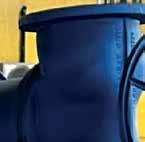






CRAFTING A REPUTATION
FOR EXCELLENCE
Established in 1987 by the Alexander family, as a way to provide the South African mining industry with alternative a er-market support through exceptional reverse engineering solutions, JA Engineering continues to design and manufacture hitech, sophisticated machines for the mining industry.
JA Engineering CEO Matimba Mahange says the company’s original equipment manufacturer (OEM) products, as well as its refurbishment capabilities, cover both underground and opencast mining.
Looking firstly at underground mining, Mahange says that in this space, the company designs and manufactures OEM mining equipment predominantly for the coal mining sector.

“The products we market and supply include continuous miners, roof bolters, shuttle cars, battery scoops and feeder breakers. This equipment is used by our customers for the mechanised mining of coal underground. We also have the capability to refurbish equipment and components for both coal and hard rock mining equipment,
even if this comes from other OEMs,” he says.

“Moreover, we are able to do this at a competitive price point, while meeting our inherent high-quality standards.”
From an opencast mining perspective, Mahange notes that JA Engineering has invested in capabilities to repair equipment and components from a variety of other OEMs. Successful refurbishments include everything from drills to surface truck major components, dozer components, dragline shutdown repair work and shovel repair work.
NEW FACILITY
“As a company, we have grown organically over the years, to the point where the business now employs more than 260 people and designs and manufactures equipment for both local and international customers.

“Today the business prides itself on being recognised as a multinational engineering solutions provider. To this end, we can reference customers in India, Australia and across Southern Africa.”
JA Engineering designs, manufactures and distributes both its equipment and a er-
market parts at its new plant in Boksburg, Gauteng. He says the facility, which measures approximately 20 000m2 under its roof, stands on a property some three times that size (60 000m2).
“It is worth mentioning that our extensive repair and rebuild capability includes electrical and mechanical repairs to surface mining blasthole drills, rope shovels, walking draglines and underground mining equipment that encompasses everything from continuous miners and battery scoops to haulage systems, feeder breakers and roof bolters.
“The business has always concentrated on building its reputation on quality, with a deep focus on manufacturing excellence and being the go-to engineering solutions provider. This is the core of the business, and JA Engineering has invested significantly in relevant technologies. We remain extremely proud of the fact that we are a mining supplier that designs and manufactures all its products within South Africa,” says Mahange.
He says the main reason for the shi to the big new property is that the business
www.samining.co.za 8 SA MINING SEPTEMBER / OCTOBER 2023 ENGINEERING COVER STORY
JA Engineering meets the varied demands of underground and opencast mines through the local design and manufacture of OEM mining equipment and after-market parts
JAE 38 Wildcub manufactured and shipped o to India.
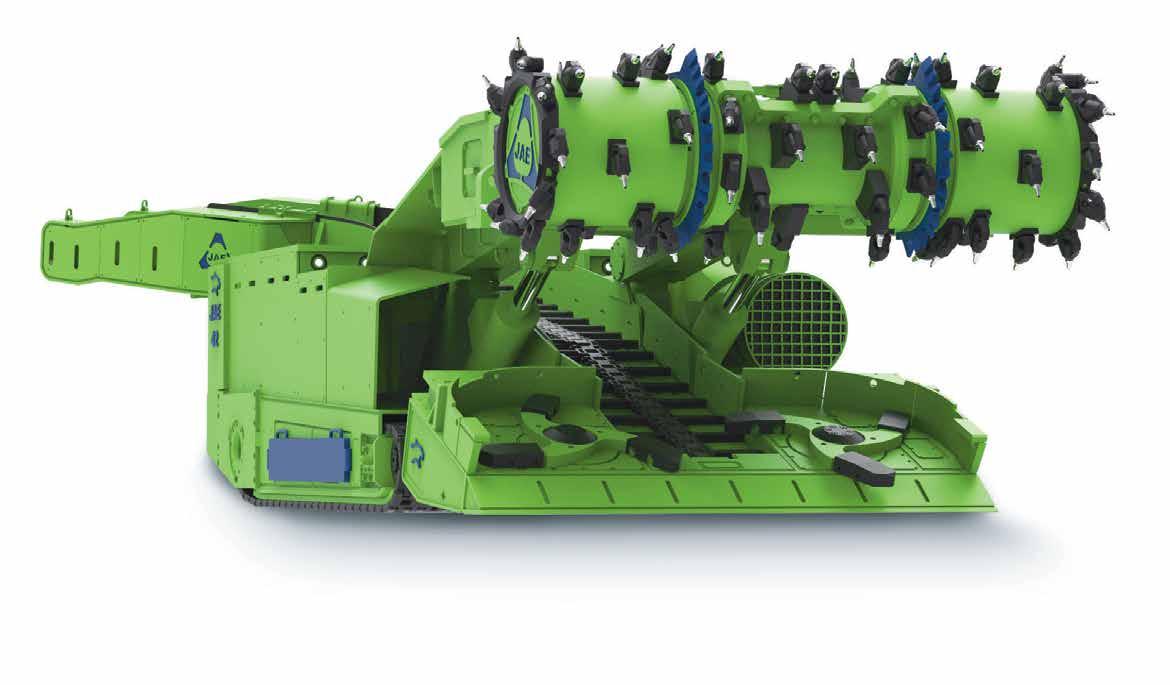






The JAE Experience Our Product. Our Service. Safety. Quality. Performance. JA Engineering Works (Pty) Ltd Increased Capacity | Surface Mining Support | Underground Mining | Design Support + 27 11 397 3237 | www.jae.co.za JAE Advanced Technology Fleet Visit us at our new premises: 60 Atlas Road, Boksburg Innovative Engineering Solutions
has managed to double in size, almost every four years.
“Our previous facility was situated in Jet Park, Boksburg, and had grown to a point where it could no longer accommodate the additional demand. We also had a limited number of cranes, which impacted on the size of repair work we could undertake. Furthermore, our product line has expanded, as more customers gain confidence in the productivity and quality of our products,” he says.
To complement the new facility, JA Engineering has invested in a new boring mill, as well as a five-axis computer numerical control machine to increase its machining capabilities.
“We have also invested in new jigs and fixtures to improve our productivity and quality, and even our electrical panels department is able to wire more panels per month than we were able to in Jet Park. Finally, our electrical technology lab is also being upgraded with the move.”
Core to the company’s growth strategy, he says, is the ability to attract the best talent in the industry. This has been possible due
to the organisation’s investment in creating the right culture and environment – one where talent can truly flourish.
INTERNATIONAL PROJECTS, TOP TALENT


“The heart of our business lies in engineering design skills, coupled with high-quality local manufacturing capability. In order to achieve this, we focus strongly on attracting topcalibre design engineers, artisans and other support technology capabilities, and we also invest in continuous training, so that our talent remains globally competitive.”
Having recently hosted an open day –where the business showcased a continuous miner, roof bolter, feeder-breaker and shuttle cars, all of which were destined for a customer in India – JA Engineering took over 100 visitors through the new facility.


“This enabled us to display and demonstrate our capabilities, including the high-quality standards we adhere to. Clearly it was a success, since we are now in the process of finalising another contract, for similar equipment, for a new customer in India.”

Other key international projects that have occurred in the past two years include the export of parts, components and equipment to Australia, to the value of R80-million.

“Looking at the interest we are receiving from abroad, it is clear that there is a growing demand for our products and services, on a global scale. JA Engineering plans to invite more stakeholders to its facility, as and when it is about to deliver significant equipment.”
He says the business currently has four shuttle cars in final assembly, which are destined for Australia. He says the company welcomes customers to come and see the massive new facility, particularly as more than 80% of the content used in manufacturing at the site is local.
“Ultimately JA Engineering is an entity that is 100% black-owned, and describes itself as being proudly South African. We are proud to be able to o er the kind of capabilities that attract the export market, while at the same time, we have a unique South African capability that we believe will be pivotal to the industrialisation of Africa,” says Mahange.
www.samining.co.za 10 SA MINING SEPTEMBER / OCTOBER 2023
“ “ KEY PRODUCTS SUPPLIED ■ Continuous miners ■ Roof bolters ■ Shuttle cars ■ Battery scoops ■ Feeder breakers
Our extensive repair and rebuild capability includes electrical and mechanical repairs to everything from rope shovels to underground mining equipment. – Mahange
JAE 42 Wildcat manufactured by JAE and launched in 2016.
JAE Battery Scoop delivered in 2023.
Shuttle car fleet.
Training unlocks performance






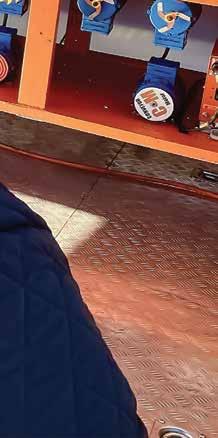


In our business, the machines do the heavy work. But it’s the people operating and maintaining them where real performance and safety lie. Invest in your most valuable asset with Komatsu training programs: online, at your OE partner, at your site.

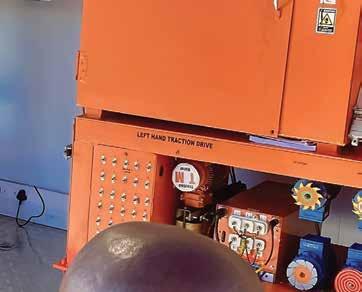

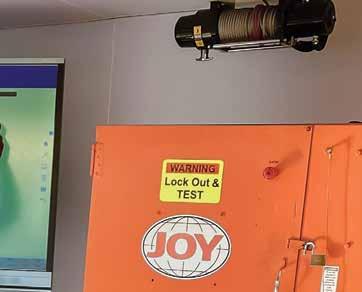


© 2023 Komatsu Ltd. or one of its subsidiaries. All rights reserved.
12 Commercial Road, Wadeville, Germiston | Tel. +27 11 872 4000
THE CASE FOR NEMLA SECTION 24G
Of the many changes made to the National Environmental Management Act, 1998 (NEMA) by the National Environmental Management Laws Amendment Act, 2022 (NEMLAA4), the amendment of section 24G is notable.
This particular section provides for the retrospective authorisation for the commencement of a listed or specified activity without an environmental authorisation, or the commencement, undertaking or conducting of a waste management activity without a waste management licence – collectively referred to as “unauthorised activity”.
According to Luca Maraschin, an associate in the mining and environmental team at NSDV, there are numerous specific listed activities under these environmental regulations that require authorisation that must be preceded by an environmental impact assessment (EIA) process. He says section 24G was introduced for those cases where one of these activities was undertaken without having the requisite environmental authorisation or waste management licence.
Luca Maraschin Associate NSDV
the unauthorised activity to cease this until the application is finalised.
“Both the increased fine and the fact of making it mandatory for the activity to cease are great deterrents, because the situation has now changed for a company undertaking any unauthorised activity – not only has the fine doubled, but they will also be obliged to immediately stop the process.
“Think about this in the context of, for example, an organisation building a solar plant for a mine, but doing so without authorisation. Not only will the fine itself hurt, but having to stop in the middle of such a project will impact everything from labour to timelines to project budgets.”
Of course, he adds, the first change is also beneficial, in that it allows the property owner or a new mining right holder, who is conducting activities on property where an unauthorised activity took place, to apply for a section 24G, even if the original party that began the unauthorised activity is no longer involved in the mine, or has refused to undertake the process themselves.
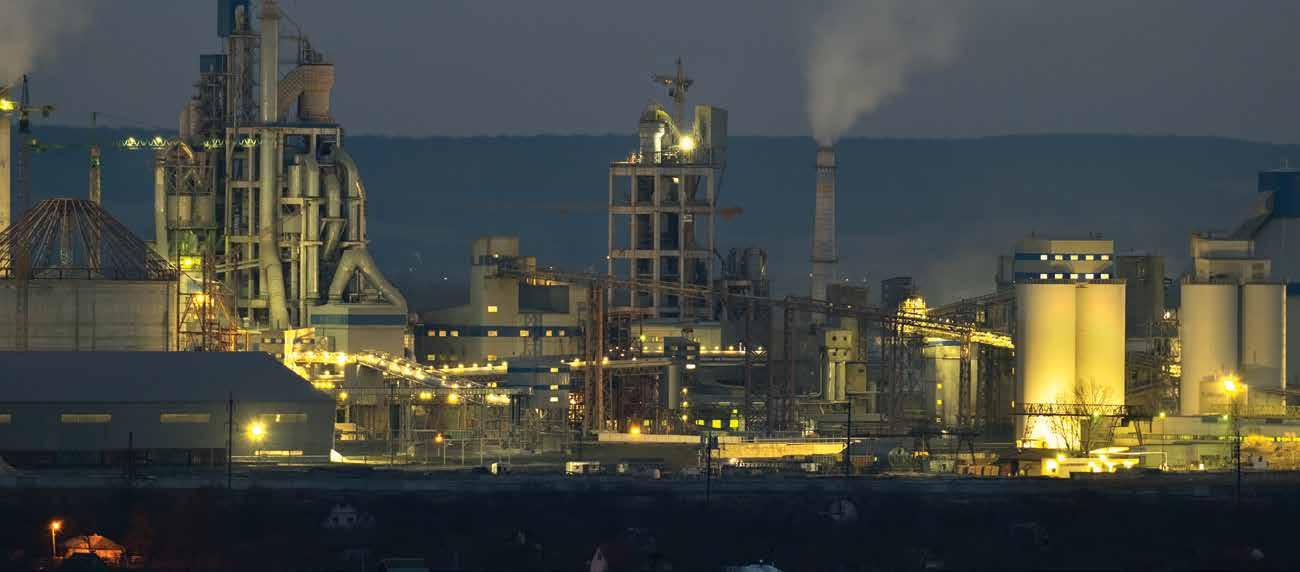
“In the past, if an entity did this, it could, ex post facto, apply for authorisation and list the activities that were undertaken without authorisation, then by paying a fine – up to a maximum of R5-million – be brought back into compliance.

“Concerns were raised about companies using this regulation cynically, adopting the principle of ‘it’s better to ask forgiveness than permission’, and also that the size of the maximum fine was not large enough.”

Maraschin adds that the amendment by NEMLAA4 is interesting, as firstly it e ectively allows the owner, or person in control of the property – as opposed to just the entity with the mining right and conducting the unauthorised activity – to apply for a section 24G to obtain the relevant authorisation. He notes too that the administrative fine has also been increased to R10m, while the competent authority must further direct the applicant undertaking
“So for example, if mining house X is mining on the property, and someone else purchases either the right or the property, the purchaser can undertake a 24G to fix an unauthorised activity undertaken by the previous owner.”
He notes that there is an additional implication for entities considering purchasing property, or allowing further activities to happen on their properties.
“If mining house X wants to sell their mine to me, the first thing I must ensure is that I won’t have to undertake a section 24G in the future. Perhaps the key takeaway here is that this highlights the need for really thorough due diligence to be undertaken, before making such a purchase.
“Ultimately, this demonstrates the importance of planning ahead, of checking all the fine print, and recognising the importance of engaging a legal specialist to help determine whether any previous – or future – projects will trigger any of the NEMAlisted activities,” says Maraschin.
www.samining.co.za 12 SA MINING SEPTEMBER / OCTOBER 2023 COLUMN FINANCE & LEGAL
© ISTOCK –Bilanol
The views expressed are the author’s own and do not necessarily reflect SA Mining’s editorial policy.
The amendments to NEMLA section 24G offer both better deterrents to unlawful operations than before, and an improved manner to achieve such compliance
Concerns were raised about companies using this regulation cynically, adopting the principle of ‘it’s better to ask forgiveness than permission’. – Maraschin
“ “























NEW APPROACHES
TO THE ZAMA ZAMA CHALLENGE

 By the Junior Mining Council’s Dr Andries van der Linde PhD (UH, UK)
By the Junior Mining Council’s Dr Andries van der Linde PhD (UH, UK)

Although the term “junior mining” is not unique to South Africa, the country is unique in several ways. The Minerals Council South Africa defines junior miners as producers having an annual turnover below R500-million per annum, which di ers from the Department of Mineral Resources and Energy’s measurement of R150m per annum.

Grouped with junior mining but recognised as a grouping with unique challenges are the “emerging miners”. This is a term indigenous to South Africa, and typically refers to small mining companies or micro-enterprises. It encompasses a diverse group of mining and mining-related entities, including prospecting and smaller producer companies and contractors.
An additional grouping that has been in the limelight for all the wrong reasons are known as “artisanal miners”, known colloquially as zama zamas. This refers to illegal mining in the informal sector, usually by individuals, groups, families, or cooperatives, with minimal or no mechanisation.
Although the Minerals Development Act recognises large- and small-scale mining,


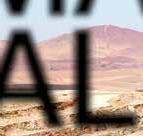

it criminalises all mining outside these categories. However, on 30 March 2022, South Africa’s Minister of Mineral Resources and Energy, Gwede Mantashe, published the Artisanal and Small-Scale Mining (ASM) Policy 2022 for implementation. Legislation is yet to be promulgated to translate the policy into a regulatory framework for implementation.

ASM POLICY
While the ASM Policy states that the ASM industry received o icial recognition following the 1994 democratic elections, no mention was made of artisanal mining. Notably, however, the ASM Policy sets out thresholds to distinguish between artisanal and small-scale miners. These are set at maximums of R1m and R10m per annum, respectively.
It’s also interesting to note the policy’s definitions for the two. Artisanal mining is defined as traditional and customary mining operators using traditional or customary means, basic methods and manual and rudimentary tools to access ore, usually on or close to the surface. Small-scale mining is defined as prospecting activities or
operations that do not employ specialised prospecting, mechanised mining techniques, chemicals, or explosives, or prospecting or mining operations that do not exceed the maximum financial limit.
To put the junior mining sector into perspective: the mining sector contributes approximately 8% of GDP, which amounted to R1.2 trillion in 2022, and provides direct employment to roughly 500 000 people. Compared to the rest of the mining industry, the junior mining sector’s contribution of R88-billion cannot be seen as insignificant.
However, approximately 1 490 mining licences have been issued to junior mining companies, making up 80% of the mining licences issued. It is estimated that they employ up to 40 300 people directly, and considering the multiplier e ect, the job creation potential of the junior mining industry can be as high as 800 000.
It is against this backdrop that we should recognise that illegal mining activities cannot be ignored – whether you call them zama zamas or artisanal miners – because their impact is diverse and all of it negative. It is estimated that the direct loss to the economy is approximately R4bn, which was estimated

www.samining.co.za 14 SA MINING SEPTEMBER / OCTOBER 2023 FINANCE & LEGAL
The challenges posed by artisanal miners – or zama zamas – are vast. However, the Artisanal and SmallScale Mining Policy 2022 seeks to change this
©
–
ISTOCK
tifonimages
by the Minerals Council to be a total of R20bn loss to the fiscus, in lost sales, royalties, and taxes in 2016. Indirect costs to the economy can be attributed to the the of copper, steel, diesel, and other materials, resulting in an expenditure on security services.
SERIOUS CONSEQUENCES
Other than that, the negative social impact of illegal mining activities can be devastating to communities. For organised crime syndicates, illegal mining is a lucrative enterprise. In South Africa, it is o en linked to rape, murder, violence, intimidation, prostitution, child abuse, collusion in criminal activities, human tra icking, and extortion.
Unintentional consequences can be even worse, such as the deaths of at least 17 people, including the deaths of three children, when toxic gas leaked from a cylinder near Johannesburg, which emergency services attributed to illegal mining activities. Other than that, there is also a serious risk to the illegal miners themselves because of unsafe working conditions and environments, resulting in unacceptable numbers of fatalities.
Although the large-scale devastation witnessed in South America, Ghana, and the Democratic Republic of the Congo is not evident in South Africa, the negative impact on the environment in South Africa resulting from illegal mining activities is still a challenge. These include damaged pipelines leaking contaminants, sinkholes resulting from water pipe spiking, underground fires and explosions, chemical and mercury contamination, and the reopening of sealed, rehabilitated mines.

There is no doubt that the junior mining industry is a significant contributor to the South African economy. It is also true that the junior mining industry is multifaceted and that, especially with the small to medium mines, there are challenges when it comes to finance, regulatory issues, and logistics, and the smaller the operation, the bigger the challenges.

It would appear that with the ASM Policy, the minister is setting out to solve the emerging and illegal mining problem. In 2019, he expressed the intention to legalise illegal mining through the issuance of licences, and the policy seems to be the first step towards that, because an illegal miner
It is estimated that the direct loss to the economy from zama zamas is approximately R4bn, while total loss to the fiscus - in lost sales, royalties, and taxes - was estimated by the Minerals Council to be a total of R20bn.
is in fact an artisanal miner. If he can achieve this, it will result in a significant increase in the contribution of the junior mining sector to the South African economy.
Established mining companies could also play a role by working with the zama zamas and making them part of their operations, while representative bodies such as the recently established Junior Mining Council could get involved as well.
This idea may look far-fetched, but the zama zamas are here to stay, and it is the mining companies who are the ones who lose the most. On the other hand, the criminal syndicates will not easily relinquish their hold on this sector – so the question is, where to next?

www.samining.co.za SA MINING SEPTEMBER / OCTOBER 2023 15
JUNIOR MINING COUNCIL
“ “ ©
Illegal mining activities cannot be ignored, because the impact of zama zamas is diverse, and all of it negative.
ISTOCK –Paralaxis
WILL TAX INCENTIVES ENCOURAGE GREENFIELD EXPLORATION?



In April 2022, the Survey of Mining Companies 2021 was published by the Fraser Institute. In it, investors explained exactly what mineral endowments and public policy factors – such as regulatory uncertainty and taxation – impacted their decision to invest in exploration in a region. Interestingly, for most organisations of this nature, around 40% of the decision is based solely on the policy factors within their chosen country, with 60% based on the region’s mineral potential.
This is concerning for South Africa, as the country has abundant mineral resources and extensive mining experience, but this didn’t stop the nation from being ranked in the bottom 10 jurisdictions on the investment attractiveness index, says Andries Myburgh, tax executive at law firm ENS.
Even the Department of Mineral Resources and Energy (DMRE) recognises the country’s challenges here, he says. The department’s own Exploration Strategy for the Mining Industry of South Africa report outlines the strengths, weaknesses, opportunities and threats relating to mining exploration, and the strategic initiatives to encourage such exploration to take place.
“It goes without saying that one of the South African mining industry’s key strengths, as noted by the DMRE, is our numerous mineral endowments, along

with the range of such minerals. Just as obviously, the country’s weaknesses have been identified as encompassing energy instability, road and rail infrastructure challenges, and unsatisfactory policy implementation,” he says.
ENCOURAGING EXPLORATION

Myburgh points out that the DMRE wants to capitalise on the country’s mineral wealth, which is why it has described a number of strategic initiatives and actions it plans to undertake, in order to encourage mining exploration.
He explains that the vision outlined in the DMRE strategy document is to secure a minimum of a 5% share in global exploration investment within a five-year period.
“This is an admirable goal and would be an impressive and notable achievement. A er all, the country needs to massively improve its attractiveness – or at least the perceptions of its attractiveness – as a mining destination, if it hopes to achieve the desired 4% increase in its share of global exploration investment.

“Unfortunately, these weaknesses have also not gone unnoticed by investors, with exploration investment decreasing significantly over time. In fact, the exploration budget was around $400-million in 2007, but had sunk to under $100m by 2018. This means that South Africa’s share of global exploration budgets has decreased to just 1%.”
“It is fair to say that the government has recognised many of the key issues impacting the economy, and is working to fix these. Among the key issues to be focused on are rail and shipping challenges, the need for more transparency, and the cutting of red tape to make it easier to do business.”
Exploration simply must be encouraged, he adds, as it’s important to continue finding viable mineral prospects. Not only does the opening of a new mine impact the economy positively, but it also helps to create jobs in remote areas and
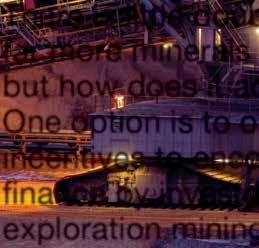
www.samining.co.za 16 SA MINING SEPTEMBER / OCTOBER 2023 FINANCE & LEGAL CORPORATE PROFILE
There is little doubt SA needs far more minerals exploration, but how does it achieve this?
One option is to offer better tax incentives to encourage equity finance by investors in junior exploration mining companies
One way to encourage more greenfield exploration is through the implementation of tax incentives for equity investors that fund exploration companies. © ISTOCK –cla ra
“ “

improve the overall development of the communities in the region.
However, if we wish to continue to explore, it is vital that we encourage the equity investments from businesses that are necessary to fund ongoing exploration.
“There is a theory that we can achieve this by o ering increased tax deductions for exploration – though this should be o ered to both the company doing the exploration, and the equity investor company investing in them, to enable the prospecting to be appropriately financed.
“Remember, this kind of equity investment is high risk – if they find nothing, the equity partner receives no returns, so the possibility of o ering tax breaks has instead been mooted,” says Myburgh.
TAX INCENTIVES
He says one way to encourage more greenfield exploration is through the implementation of tax incentives for equity investors that fund exploration companies. One concept that is being considered is the system of “flow-through shares” investment by equity investors.
“Basically, the way a flow-through share model works is that it allows for the
provision of equity funding by investors into those companies that carry out exploration activities, and thus incur expenditure which qualifies for a tax deduction.
“While the exploration company carries out its prospecting, it would not be deriving any income, and yet it would be accumulating deductible expenditure. With the flow-through model, these deductions are renounced by the prospector in favour of the equity investor shareholder, which can then enjoy the benefit of decreasing its tax liability as a direct result of investing in the exploration company.
“The idea is to implement a similar approach to what Canada has done, but with a definite South African flavour, which should encourage organisations to invest in and fund exploration and prospecting in the country by way of equity funding as opposed to debt funding.
“A lot of work has already been done here, including by ENS, which has been assisting on a pro bono basis, giving input from a tax perspective as to how this could work.”
He says experts suggest that o ering such tax breaks may cause some erosion to the fiscus in the short term, but this will be more than made up for by the job creation and
IMPACTING THE ECONOMY
In terms of economic improvement, economists suggest that SA’s current 1% share of exploration spend will potentially add:

■ R2.8-billion to GDP on average per year.
■ Create and/or sustain an estimated 7 700 direct and indirect jobs on average annually.
■ R740-million to total government revenue, through the collection of direct and indirect taxes.
If this share is increased to 5%, as the DMRE hopes, this will potentially generate the following economic activity:
■ Potentially add R14.2bn to GDP on average per year.
■ Create and/or sustain an estimated 38 400 direct and indirect jobs on average a year.
■ Add a potential R3.7bn to total government revenue, through the collection of direct and indirect taxes.
additional taxes that a fully implemented project will bring to the table.
“We are starting to witness a shi , with plans to implement the DMRE’s new cadastral system, and the department bringing together a working group including the JSE, Minerals Council SA, and the Council for Geoscience, to develop a fully-fledged and workable plan to increase investment in exploration.
“It is clear that there are positive signs that the right things are starting to happen. Once the cadastral system is up and running, and should these tax incentives be implemented, we will at the very least have laid the groundwork to enable SA to make the e ort to increase its share of exploration spend from 1% to 5%.”
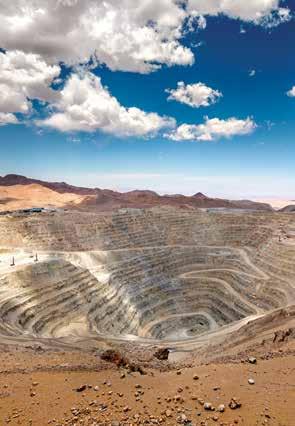
www.samining.co.za 18 SA MINING SEPTEMBER / OCTOBER 2023 FINANCE & LEGAL CORPORATE PROFILE
“
It is fair to say that the government has recognised many of the key issues impacting the economy, and is working to fix these.
“
© ISTOCK –Nneirda
© ISTOCK –tifonimages
OPTIMISING VALUE BY

MINIMISING MINING WASTE



 By Levi Letsoko
By Levi Letsoko
The gold mining sector in SA has faced numerous challenges recently, ranging from compromised investment policies and frameworks, to the scourge of illegal mining. National news feeds share a common view when describing the sector as embattled, and the sector has been put under a microscope in search of practical solutions to mitigate the lingering impact of a recovering business environment that is still trying to find its place in the post-Covid marketplace.
Based on a report published by the South African Reserve Bank, the terms of trade (including gold as the key commodity for the economy) “improved in the first quarter of 2023 as the rand price of exported goods and services increased while that of imports decreased.” These green shoots, however, can only be fully beneficial if the mining industry operates under an investor-friendly climate.

Mining companies have transparently expressed their drive to find innovations that limit indirect or method induced mineral loss from the neglected phases of the mining process. One of the inherent contributing factors in excessive mineral loss through waste is the outdated extraction methods coupled with unwavering mineral testing, processing and smelting techniques

performed on the extracted compounded material that is unearthed during the mining process.
INNOVATIVE EXTRACTION TECHNIQUES

The mining process is much more complex than merely extracting ore from the earth. It requires a lot of pre-planning and process management before setting out the actual extraction plan. In order to preserve the mined ore, it is imperative for mining operations to integrate methods that are
It makes sense for these companies to invest heavily in laboratory solutions and services in order to gain, collect and utilise the data around the cycle of damage caused by waste – in order to optimise value while minimising waste.
conscious of the need to stage practical and accurate waste reduction methods. Methods that guarantee high output in terms of extraction of ore, while minimising the damage to the immediate environment.
A proper mining process plan or design naturally prioritises accurate ore extraction from the earth, but that process is not always a seamless encounter for the operations manager. The integration of blasting agents in soliciting ore from the core of the earth makes a measured and properly managed outcome more elusive.
As a result, the process will then produce raw ore, compounded with surrounding materials, plus hydrocarbon waste, waste rock, chemical waste and tailings. Underground mining methods on their own don’t o er much in guaranteed separation of ore from surrounding material. This pushes mining processes to prioritise ore preservation by deploying means that don’t destroy the commodity.
IMPROVED ORE TESTING METHODS
As observed through industry trends and developments, innovation has blasted across the mining process design perimeters, by introducing new insights, resources and tools to help improve mineral testing processes. Usually, this step in the mining design plan is an in-house duty, as this approach allows
www.samining.co.za SA MINING SEPTEMBER / OCTOBER 2023 19 GOLD
Outdated extraction methods, mineral testing, processing and smelting techniques all contribute to excessive mineral loss through waste. Here’s how mines are starting to minimise such losses
©
© ISTOCK –
Nordroden
ISTOCK –Kakmyc
GOLD
mines to secure the commodity without external or outsourced interactions.

Major laboratories and laboratory equipment manufacturing companies have received a significant boost from the mining sector by aligning with a constant reassurance from the rising demand for innovative utility stacks.
These stacks that illustrate an understanding of what is required for appropriate testing facilities and equipment to be effective in their role in their production process. Advanced testing processes that improve the eradication of surrounding material from mined ore, while securing maximum value from the mined ore, remain an industry benchmark.
While most water and electro-chemistry inventions have broken the mould in this regard, it is imperative for mining companies to keep up with leading solutions in this regard, not only locally but internationally. PerkinElmer South Africa is a renowned geology and mining specialist, operating in numerous countries. The company has made incredible explorations in its specialised field, through research and studies conducted in observing the various mining landscapes’ physical structures, its layout and on-thesurface rocks.
In its seasonal report in the Analytical Reporter, Issue 3 of 2023, the organisation reaffirmed its commitment to advancing the insights gained through its initiatives to its client engagements when delivering the service offering.
According to PerkinElmer: “These generative and targeted explorations are deployed by the company to ascertain mining sites, accurately predicting the quantities of available ore and the concentration levels of the available commodity.”
ALTERNATIVE MEANS OF OPTIMISING VALUE
Microsep Pty (Ltd) is a South African organisation that has deployed the Fire Assay method as the accepted method for determining the amount of precious metals in metal ore. In an article published by the Analytical Reporter, Issue 3 of 2023, Microsep indicated that assay laboratories and mines, weighing regulus, lead buttons and ore samples require accurate and reliable instruments necessary to assess the amount of precious metals such as gold, silver and platinum in metal ore”.
As a result, the company has manufactured inventions that promise low repeatability (of monotonous processes) and stabilisation time, so that the weighing of precious metal samples for fire assay applications is reliable and fast. This avails specially designed funnel stacks that enable accurate weighing and testing of metal ore,
including in the smallest of samples.
In fact, for decades, the government gazette on the mineral and energy sector has highlighted the importance of having an economy that relies on mining to understand its obligation to be consistently cautious around issues of mining waste and its impact on the environment. The current legal frameworks and policies, designed to hold these companies liable for any damages occurring as a result of these mining activities, are viewed as handling mining companies with kid-gloves.
As a proposed norm, it makes sense for these companies to invest heavily in laboratory solutions and services in order to gain, collect and utilise the data around the cycle of damage caused by waste – in order to optimise value while minimising waste. More importantly, identifying the resources that can help minimise losing ore that is naturally absolved as waste.

www.samining.co.za 20 SA MINING SEPTEMBER / OCTOBER 2023 GOLD
“
“
Advanced testing processes that improve the eradication of surrounding material from mined ore, while securing maximum value from the mined ore, remains an industry benchmark.
© ISTOCK –jasonbennee
© ISTOCK –JONGHO SHIN















SADC’S RARE EARTHS REVIVAL

Marula Mining, an Africa-based battery metals investment and exploration company, has three SADC-based mines that will be key to a renewable future
By Rodney Weidemann
As the world shi s from the fossilfuel economy to a renewable future, there is a desperate need for the metals and minerals that will facilitate such a transition. This is the space Marula Mining plays in, as an Africa-based battery metals investment and exploration company.
The company’s focus is on producing and exporting high-value commodities such as lithium, tantalum, graphite, cobalt, rare earths, copper and nickel – all of which are of increasingly strategic importance to modern technologies and the global economy.
In this feature, we will take a closer look at Marula’s three key Southern African Development Community (SADC)-based projects, and their impact on both the renewable future and the mines’ surrounding communities.
NKOMBWA HILL, ZAMBIA
Unlike most of its other projects, the company currently doesn’t have a majority interest in this one, due to certain regulatory issues – although it plans just such a stake in the near future. According to CEO Jason Brewer, the project involves a major mineralised carbonate complex.
He says previous exploration has defined

a JORC 2012 Compliant Total Indicated and Inferred Mineral Resource of 21.8 million tonnes, at a grade of 7.06% P2O5 and 1.17% Total Rare Earth Oxides.
“What’s exciting is that the reported Total Mineral Resource was defined on an area of less than 5% of the Nkombwa Hill deposit. This highlights the significant resource upside potential that exists for both phosphate and rare earth elements, as well as tantalum and niobium mineralisation,” he says.
“This mine is important, because the focus on rare earths is key to the green energy transition and makes this a very attractive project, due to the fact that the minerals produced here are so in demand for the new industries of the 21st century.”

He notes that while Marula is keen to get things started, certain regulatory issues need to be resolved before the company commits significant additional capital to the project. He says Marula hopes to increase its shareholding from 23.75% to more than 50% in the near future.
“Marula is dedicated to assisting the communities surrounding its projects, but the company does not come into a region with pre-defined projects. Instead, we work with the communities to find what their
most pressing needs are, and then we attend to these.
“We understand that we cannot adopt a one-size-fits-all approach. Instead, we sit down and listen to what the community’s requirements are – be these improvements to education, infrastructure or something else – and we then assist with these specific projects.”
KINUSI COPPER MINE, TANZANIA
A far more developed project than the previous one, Marula has a 75% commercial interest in 10 primary mining licences at Kinusi, and considers the investment to be firmly in line with the company’s battery metals focus, and its identification of highgrade, near-term production and cashflow generating projects.
“This is probably the most exciting project we have,” says Brewer, adding that Marula has seen some special copper projects in its time, but believes that this one looks especially exciting. We are thrilled to be in a partnership with locally based Takela Mining, as we believe copper mining is about to take o in Tanzania.
“In fact, we consider this mine to be a game changer for the region, chiefly because Tanzania is mostly not known for copper, but
www.samining.co.za 22 SA MINING SEPTEMBER / OCTOBER 2023 PROJECTS IN SADC
© ISTOCK –J-Picture
Engineering solutions for the Global Mining Industry



Mining Geotechnical Ventilation Mechanical Electrical Metallurgical
SOUTH AFRICA OFFICE: +27 11 476-7091
Etienne de Villiers: +27 83 327 6517 / etiennedv@baraconsulting.co.za
Jim Pooley: +27 82 373 0796 / jim@baraconsulting.co.za
Clive Brown: +27 82 557 5373 / clive@baraconsulting.co.za
www.baraconsulting.co.za

UNITED KINGDOM OFFICE
Andrew Bamber: +44 744 486 4046 / bamber@baraconsulting.co.uk
www.baraconsulting.co.uk
rather for other minerals, and this massive deposit will put the nation on the world map as a huge mining region.”

Brewer says at this mine, Marula can extract up to 20 000 tonnes of copper per year, which at current rates would be worth almost $60-million per annum. More crucially, he adds, the company has a projection of genuinely high-grade (up to 40%) copper from the mine.
“At the end of the day, copper is exported to the same o taker as our lithium, so we will be strongly targeting the same renewables market. There is tremendous demand for these minerals from the electric vehicle and battery metals markets. With the market for copper only increasing in scope, the fact that we have access to such a high-quality copper deposit can only help our business, moving forward.

“At Kinusi, our social investment programmes are slightly di erent. In this region, there is little by way of employment, outside of farming or government work. Thus, we will be providing full-time employment to people in the area who may never have held a job before. This will have a huge impact in terms of job creation, skills development and quality of life on the entire community.”
BLESBERG MINE, NORTHERN CAPE, SA Blesberg Mine, according to Marula, is one of the largest known economically mineralised pegmatite deposits, and has been the largest single source of tantalum in the country.
Historic production from the Blesberg Mine has included spodumene concentrate (containing lithium) and tantalite, as well as feldspar, bismuth, beryl, and mica.
“Lithium grades of the samples assayed demonstrate a high-grade and high-value lithium product that can potentially be recovered from the existing stockpiles, without incurring high upfront capital costs and high mining and processing costs,” he says.

“In addition, previous drilling and trenching in 2017 at the Blesberg mine confirmed areas of spodumene lithium mineralisation present in the highly zoned pegmatites. Due diligence work has led us to believe that there is potential to increase the spodumene (lithium) resources in the pegmatites, with the view to accelerate new mine development – given the robust market conditions and market pricing of lithium concentrates.”
When to comes to supporting the surrounding communities, all employees at the mine are sourced from surrounding

Marula Mining focuses on producing and exporting highvalue commodities such as lithium, tantalum, graphite, cobalt, rare earths, copper and nickel.
areas, boosting job creation in a part of the country were unemployment is rife, he says.
Marula aims to draw on a workforce of around 50 to 75 people initially, and as the business moves forward, to expand its sourcing from these local communities.
“We are also involved in providing local services, supplies and consumables, and we are investing in education and training as well. Similar to our other projects, we work closely with local charities too, as we focus on improving three key areas, namely education, health and sport, in the region.
“Although Marula Mining is listed in London, unlike other companies listed there, our headquarters remain on the continent in Nairobi, Kenya, and we continue to view ourselves as an African company.
“Because we recognise this as our home, we work in an environment where we are not merely seeking to build a business, but rather a long-term project that encompasses the communities and people around our mines, and boosts the local economy,” says Brewer.
www.samining.co.za 24 SA MINING SEPTEMBER / OCTOBER 2023
© ISTOCK –Fotonio-Bcn
Nkombwa Hill is important, because the focus on rare earths is key to the green energy transition and makes this a very attractive project.
“
– Brewer
“
© ISTOCK –Michael Grund © ISTOCK –Media
PROJECTS IN SADC
WE PROVIDE GIW ® SLURRY PUMP SOLUTIONS

Wear Resistant, High Performance –Global Quality Mining Pumps.




Through GIW® Slurry Pumps, KSB is an innovative partner that provides you with the best and longest wearing slurry solutions. We are your partner over the entire lifecycle of your GIW® slurry pump.
KSB Pumps South Africa is a globally recognized pump solutions provider that manufactures globally recognized products locally to the highest quality standards both internationally and locally.

We not only manufacture and service your slurry pumps, we offer total slurry solutions to your industry.
One team - one goal.
KSB Pumps and Valves (Pty) Ltd


Tel: +27-11-876-5600
www.ksb.com/en-za
Level 1 B-BBEE Supplier

LCC MDX LSA LCV
THE IMPORTANCE OF COMPLIANCE MONITORING
In an era of heightened environmental awareness and regulatory scrutiny, the importance of e ective water and air compliance monitoring cannot be overstated. Ensuring that industrial and commercial activities do not harm our natural resources, or compromise the air we breathe, is a shared responsibility that demands continuous vigilance.
WATER COMPLIANCE MONITORING
Water is an invaluable resource essential for sustaining life and supporting ecosystems. However, various human activities, ranging from industrial processes to agricultural run-o , can introduce pollutants into water bodies, posing significant risks to aquatic life and human health. Water compliance monitoring involves systematic assessments of water quality, to ensure that pollutant levels remain within permissible limits.

KEY ASPECTS OF WATER COMPLIANCE MONITORING:

Regular sampling and analysis: Regulatory agencies and organisations employ a combination of automated sensors and manual sampling techniques to monitor a wide array of parameters such as pH, dissolved oxygen, temperature, turbidity, and the presence of contaminants like heavy metals, pesticides, and pathogens.
Data integration and analysis: Advanced data analytics and modelling are used to detect trends, potential hotspots, and anomalies in water quality data. This proactive approach helps identify emerging issues before they escalate into severe problems.
Real-time monitoring: Technological advancements enable real-time monitoring systems that provide instant alerts in the event of sudden changes in water quality, enabling prompt responses to mitigate risks.
AIR COMPLIANCE MONITORING
Air quality directly impacts human health and the environment. Emissions from vehicles, industrial processes, and energy production can release pollutants like particulate matter, volatile organic compounds, nitrogen oxides, and sulphur dioxide into the air. Air compliance monitoring plays a crucial role in tracking these pollutants and ensuring that they remain within acceptable limits.
KEY ASPECTS OF AIR COMPLIANCE MONITORING:

Emission source monitoring: Industries and facilities are required to monitor emissions from stacks, vents, and other sources. Continuous emission monitoring systems track pollutants in real time, providing a comprehensive picture of air quality and compliance.
Ambient air quality monitoring: Networks of air quality monitoring stations are strategically placed to measure pollutant


concentrations in the atmosphere. These stations provide a comprehensive understanding of air quality across di erent regions.
Remote sensing technologies: Satellitebased and remote sensing technologies o er insights into air quality on a larger scale, aiding in the identification of pollution sources and their dispersion patterns.



CONCLUSION
Water and air compliance monitoring serve as the front lines in our e orts to preserve the environment and ensure public wellbeing. As technology continues to advance, monitoring methods become more sophisticated and data-driven, enabling us to make informed decisions to safeguard our natural resources and mitigate the detrimental e ects of pollution. By maintaining a watchful eye on our water and air quality, we can pave the way for a cleaner, healthier, and more sustainable future.
www.samining.co.za 26 SA MINING SEPTEMBER / OCTOBER 2023 SAFETY, HEALTH & ENVIRONMENT CORPORATE PROFILE
Envass water and air compliance monitoring serves as the front lines in our efforts to preserve the environment and ensure public wellbeing
Envass conducting a baseline air quality assessment (Particulate Matter) by using a MET One Mass monitor.
Gravimetric dust fallout monitoring and sampling.
Water quality monitoring field measurements. (pH, EC, temperature)
Envass conducting a baseline air quality Assessment (Particulate Matter) by using a MET One Mass monitor.
Your Partner in Calculating Environmental Solutions
The ENVASS Group is a distinguished provider of accurate environmental solutions within the South African mining and beneficiation sector. ENVASS stands renowned for its unwavering commitment to delivering independent and exceptionally effective environmental services across diverse industries in South Africa. Leveraging our extensive environmental expertise, we facilitate value-added services by seamlessly integrating costeffective environmental compliance and performance solutions.
We recognize the complexity of environmental compliance and respond by staying abreast with legislative changes and interpretations. We engage in benchmarking and collaborative discussions with our clients, alongside our network of legal experts, to offer an exclusive array of compliance and technical environmental audit solutions.
Boasting a quarter-century of environmental auditing experience, our services include:

Water Use Licence Compliance and Technical Audits
Waste Management Licence Compliance and Technical Audits

Environmental Management Programme Performance Assessment
National Norms and Standards Compliance Audits and Review

Atmospheric Emission Licence Compliance and Technical Audits
Biodiversity Management Plan Implementation Audits and Reviews
Environmental Control Officer Audits
ISO 14001 Internal Audits
Our Audit reports link to clear interpretable documented evidence, strong visualization and an alignment with existing document controls on site. Feel free to reach out to our proficient team of auditors to inquire about recommendations or obtain a quotation for any of the services mentioned above.
Contact us today to learn more about how our consulting services can help your mining company achieve its environmental goals in a sustainable and responsible way.

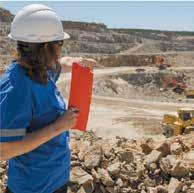
012
460 9768 | info@envass.co.za | www.envass.co.za
| Gauteng | North West | KwaZulu-Natal | Western Cape
Office locations:
CAN PHOSPHATE MINING BE DONE SUSTAINABLY?




Sustainability is key to mining, and phosphate production
 By Rodney Weidemann
By Rodney Weidemann
Phosphate mining is considered essential for global agriculture and the role it plays in food security. Like many mineral extraction processes, responsible production and manufacturing processes are vital to mitigate potential environmental damage and ensure a safe working environment.
These activities are governed by strict legislation, and a range of regulations designed to protect human health and safety, biodiversity, and to limit the extent of any polluting contaminants.
Mark Maynard, COO at Kropz, notes that at the company’s Elandsfontein mine, environmental and safety mitigation measures are engineered into its design and were implemented at the inception phase.
“At Elandsfontein, our focus has been on minimising habitat destruction; maximising land reclamation; responsible management of water resources and intensifying wastewater treatment; reducing chemical usage; and – through a focus on R&D – developing cleaner extraction and processing technologies,” he says.
To this end, Elandsfontein employs a full-time rehabilitation team, whose activities are closely aligned with the mine’s environmental management programme (EMPR).
Adelaide Ruiters, founder and CEO at Adelaide Ruiters Mining and Exploration, which is developing the Zandheuvel Phosphate Mine and Beneficiation Plant in Saldanha Bay, points out that many phosphates contain high levels of cadmium, which is illegal in SA.
Cadmium levels of more than 20 ppm may not be imported or used for agriculture production in SA, since cadmium is a toxic heavy metal that causes kidney and cardiovascular diseases, as well as cancer.
“The phosphates we produce are among those that have very low cadmium content, making them much healthier. However, the biggest problem in SA is that around 70% of our phosphates are actually imported. Are there any assurances that imports like these, and their cadmium levels, are being properly policed at the ports?
“Ultimately, we must remember that price is o en key in this market, so the imports coming from elsewhere may be cheap, but there is every likelihood they are also high in cadmium.”
It is for this reason, among others, that she indicates she is trying to form a Phosphate Producers Association to lobby other producers to advocate for both healthier phosphates and phosphate mining approaches. It would also be to ensure that South African phosphates are used in the South African agriculture value chain.
WATER ISSUES
In a water-stressed country like South Africa, explains Ruiters, a strict focus on water management and e iciency measures is clearly appropriate.
She notes that tailings dams are broadly at odds with the principles of sustainability, which is why her company uses filter presses to remove the water, so that it can be circulated back into the process.
“It’s worth mentioning that beneficiating phosphate rock
www.samining.co.za 28 SA MINING SEPTEMBER / OCTOBER 2023 SAFETY, HEALTH & ENVIRONMENT
comes with its fair share of challenges. We look at the efforts such producers are making to remain sustainable
©
ISTOCK –BrianBrownImages
HOW TO UNDERTAKE SUSTAINABLE PHOSPHATE MINING AND PRODUCTION


Grant Dreyer, MD for Future Metals and Materials at Afrimat, suggests that there are several areas of focus required to achieve sustainability in the mining process:
■ Exploration techniques: Identifying economically viable deposits early reduces exploratory digging and associated environmental disturbance.
■ E icient resource management: Minimising waste generation and resource depletion, through e icient practices such as mine planning and processing technologies.
■ Rehabilitation: A commitment to restoring mined areas and reducing environmental impact.



■ Community engagement: Continuous engagement with local communities fosters cooperation and awareness, while the actual mining and production leads to job creation and improved living standards for communities.

■ Continuous monitoring: the monitoring and analysis of production processes, with the aim of reducing potentially harmful contaminates, by-products and waste.
■ Regulatory compliance: It is vital to stay on the right side of the law, and authorities play an important role in enforcing regulations and compliance.
concentrate allows you to produce phosphoric acid, which is a key element in producing fertiliser and other agents, like dishwashing liquid. It can even be further beneficiated as a food chain preservative, and can be used in items like soap and toothpaste,” she says.
“However, when such beneficiation is undertaken – through Direct Froth Flotation Technology – diesel is usually used as the frothing agent. Because of the carbon footprint this creates, we have replaced diesel with a canola oil derivative, which is
far more sustainable and assists significantly in producing low carbon footprint phosphates.”

Ruiters adds that SA’s water scarcity issues mean that it is not really sustainable to use potable water in the beneficiation process. Therefore, her company has forged an arrangement with the local municipality, which allows them to utilise treated municipal wastewater instead.
“In the end, our beneficiation process has been made more sustainable in three ways. Firstly, we replaced the frother diesel with canola; then the fatty acid traditionally used in the process is now also derived as a byproduct of canola production; and finally, we replaced caustic soda with potassium hydroxide, which allows us to produce a greener, more sustainable low carbon phosphate fertiliser product, targeting more sustainable organic agriculture practices.
“We also designed a pipeline to pump our final product to the logistics facility at the Saldanha Bay deep sea port. In this way, we eliminated the need to have trucks transporting the product to the harbour, mitigating the dust and air pollution a mining operations causes.”
ARME is on track developing its new Zandheuvel Phosphate Mine and Beneficiation Plant in Saldanha Western Cape South Africa, to become one of the few phosphate producers in the world set up to produce low carbon, sustainable and environmentally friendlier beneficiated sedimentary phosphate rock. Certainly in South Africa, we are the only phosphate producer known to have successfully replaced all beneficiation chemical reagents with organic environmentally friendly reagents so as to produce a low carbon environmentally friendlier phosphate rock for sustainable agriculture practices. We are Proudly SA Black Woman Owned. Supported by the Industrial Development Corporation, Anglo Sefa Mining Fund and VBKOM.
Contact Adelaide Ruiters CEO and Founder adelaide@arme.co.za 0027 847234555
www.arme.co.za
The phosphates we produce are among those that have very low cadmium content, making them much healthier. However, the biggest problem in SA is that around 70% of our phosphates are actually imported – Ruiters
“
“
TECHNOLOGY TO THE RESCUE

According to Grant Dreyer, MD for Future Metals and Materials at Afrimat, technology can also be embraced throughout the value chain.

“From the identification of economically accessible resources, through to mine scheduling, monitoring and processing, and on to data analytics to help ensure compliance, technology offers plenty to the sector. Included in this is its ability to assist in the overall reduction of environmental and safety risks.
“These tools, together with a firm commitment to regulations, enable planning that helps to optimise mining and production processes, while reducing emissions, safety risks and other environmental impacts,” he explains.
Kropz’s Maynard points out that by integrating these modern, digital technologies into the overall mining planning and operation, organisations can significantly improve many aspects of the mining process.
M84 GEOTECH

“However, there are a few caveats. Improving your business using technology relies on observing practices and disciplines such as sound investment in research and development (R&D), collaborating closely with technology providers, as well as collaboration between mining companies and regulatory bodies. It is also imperative to ensure that the workforce is trained to use the digital tools.”
Digital technology plays a key role in managing sustainable mining initiatives and reducing a mine’s environmental risk profile, he continues. Elandsfontein, for example, has bespoke training programmes in place to keep employees skilled in the latest developments in this area, in order to benefit from these new innovations.
“Sustainable phosphate mining relies on an integrated collaborative approach, involving all the industry stakeholders –government at local, provincial and national level, NGOs, communities and others. Ultimately, it is important to balance the need for phosphates, which is critical for food security, with responsible environmental stewardship, to minimise any potential ecological damage,” says Maynard.
Rockfall Protection and Slope Stabilization Solutions for Open Pit Mines
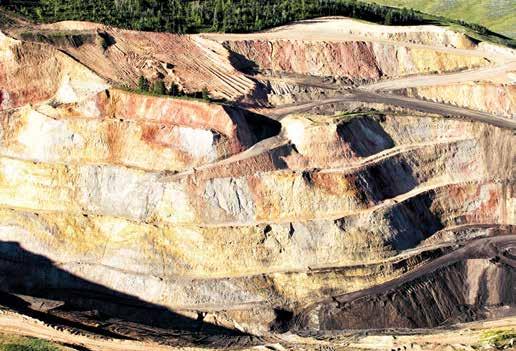


As a company we pride ourselves in having 100% completion rate on every project we have done and also keeping a 100% safety record on-site. This is a big deal for us because we do high risk and high priority projects and that’s why we say, “Safety is Our Priority.” The systems we use to keep open pit operations safe from rockfall hazards and slope failure are one of the best in the market and with us as a contractor you are guaranteed a professional service and safest installation methods. The use of rope access techniques makes it possible for us to install the systems with minimum interruption to production. We can access high areas using the safest methods while keeping your miners and equipment safe from possible rockfall hazards.
We have successfully completed complicated projects such as installing a 200m x 200m drape mesh system on a rocky highwall and moved tricky positioned boulders on high walls.
Most if not all of our mining clients, safety is very important to them and as a company that’s what we bring on-site, safety. Rockfalls are a very serious risk in open pit mines and if such risk is not managed or controlled, lives could be lost and equipment damaged. The solutions can come in the form of preventative measures such as installing slope monitoring prisms or through protection systems such as drape mesh, slope stabilization or catchfences.
SAFETY, HEALTH & ENVIRONMENT
Tel: 015 023 1400 Cell: 072 203 8405 Email: info@m84geotech.co.za, admin@m84geotech.co.za Address: 11 Sussex Street, Mokopane 0601 26 Rhodesdrift Street, Building 4, Suite 3 Rhodesdrift Office Park, Bendor Polokwane 0699 Socials: Instagram: m84_geotech Linkedin: M84 Geotech Web: www.m84geotech.co.za
© ISTOCK –Brian Brown
“
At our Elandsfontein mine, environmental and safety mitigation measures are engineered into its design and were implemented at the inception phase. – Maynard
“
MINING CAN BE A THIRSTY BUSINESS
By David Noble, CCO at Swedish drinking water and beverage company Bluewater


As one of the country’s most significant industries, mining is crucial to South Africa’s economy and provides valuable resources that power various sectors. However, amid the grit and determination lies an o en-overlooked challenge – ensuring clean drinking water for those who toil above or beneath the earth’s surface.
The mining industry in SA is a force to be reckoned with, thanks to rich mineral reserves and history dating back centuries. The country is blessed with abundant natural resources that drive global demand, from gold and diamonds to platinum and coal.
However, like any industry, the mining sector faces its fair share of challenges. While the fluctuating prices of commodities on the international market can significantly impact profitability, there’s also increasing pressure for sustainable practices and stricter demands for safer, healthier work practices.
Despite these hurdles, South Africa remains a significant player in the mining world. Its vast mineral wealth continues to attract domestic and foreign investment, bolstering job creation and economic growth. The industry employs thousands of workers across various disciplines – from engineers and geologists to miners working tirelessly underground.
Furthermore, advancements in
technology have revolutionised the way mining operations are conducted. Modern machinery allows for more e icient extraction processes while minimising environmental impact. Remote-controlled drones survey vast terrains with precision and accuracy, aiding exploration e orts.
Recently there has been increased focus on responsible mining practices, prioritising worker safety and wellbeing and environmental stewardship. This shi towards sustainable operations benefits local communities and enhances the overall reputation of South African mines internationally.
CLEAN DRINKING WATER

Today’s mining industry in South Africa faces the key challenge of providing clean drinking water for mine workers. This issue arises from various factors, such as water scarcity, contamination, and inadequate infrastructure.
Water scarcity poses a significant problem in many mining regions, where access to fresh water may be limited. With growing demands from both mining operations and their surrounding communities, ensuring an adequate supply of clean drinking water becomes even more challenging.

Contamination of available water sources is another concern faced by mines.

Working in a mining environment can expose individuals to various contaminants and pollutants, making them more susceptible to gastrointestinal infections and water-borne diseases.
Chemicals used in the extraction process can seep into groundwater or nearby rivers and streams, making them unsuitable for consumption without proper treatment. In addition, poor waste management practices can further pollute these water sources.
Moreover, more infrastructure is needed to provide clean drinking water at SA mines. In some cases, ageing pipelines or storage facilities may lead to leaks or bacterial growth within the system. This not only compromises the quality of the water, but also increases health risks for the miners.
Addressing these problems requires proactive measures from both mining companies and regulatory bodies. For example, implementing advanced filtration

www.samining.co.za SA MINING SEPTEMBER / OCTOBER 2023 31 WATER MATTERS
South Africa’s mining industry faces challenges when seeking to provide clean drinking water in the nation’s demanding mining environments – yet this is vital for miners’ wellbeing and productivity
WATER MATTERS
©
–
ISTOCK
Cegledi
David Noble.
systems and wastewater treatment technologies can help remove contaminants e ectively, while conserving precious resources like fresh water.
Investing in improved infrastructure with better monitoring systems will aid in detecting any issues promptly, and enable appropriate action to be taken before they escalate into more significant problems.

Ensuring clean drinking water at South African mines is crucial for safeguarding miners’ health and wellbeing and for sustainable development within local communities a ected by mining activities. By prioritising this aspect upfront, and adopting innovative solutions, it is feasible to create safer work environments while minimising the impact on precious natural resources.
VITAL TO SUCCESS
Clean drinking water is essential for the wellbeing and productivity of workers in any industry, and the mining sector is no exception. Providing clean, high-quality water to miners has numerous benefits beyond mere hydration.
Access to clean drinking water helps promote good health among miners.

Working in a mining environment can expose individuals to various contaminants and pollutants, making them more susceptible to

gastrointestinal infections and water-borne diseases. Ensuring miners have access to clean water sources can minimise or even eliminate these risks.
Clean drinking water at mining sites also improves worker morale and productivity. Dehydration can lead to fatigue, decreased concentration levels, and reduced cognitive function – all detrimental to someone’s ability to perform their job e ectively. Employers can help keep their workforce energised and focused by providing clean water onsite.
Furthermore, the availability of clean drinking water promotes sustainable practices within the mining industry. Many mines rely on groundwater sources or nearby bodies of water. If these sources become contaminated, due to improper

waste management or other factors related to mining activities, it poses a risk for human consumption and jeopardises local ecosystems.
In conclusion, investing in easy-to-install infrastructure and other solutions from recognised leaders in this field will help mines to ensure clean water is available – thereby safeguarding employee health and wellbeing, and improving overall work performance while encouraging environmental stewardship.
Ultimately, it is crucial for companies operating in this sector to not only comply with regulatory standards, but also to go above and beyond, by implementing comprehensive strategies that prioritise the provision of safe potable water throughout their operations.
Structa Technology’s Prestanks are hygienically safe, cost effective and a reliable way to store water for commercial sectors, private sectors and even for personalized storage. Temporary or permanent erection at mines, powerstations, building sites, hospitals, water affairs,municipalities, rural communities and agriculture.


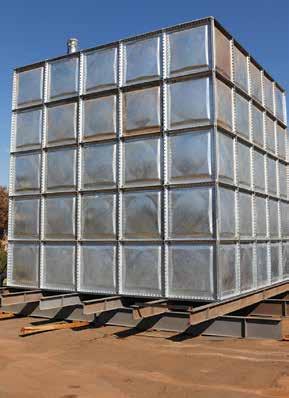

Specialists in the manufacturing of domestic and industrial water storage









WATER MATTERS
T: +27 (0)16 362 9100 | Meyerton watertanks1@structatech.co.za Director: Rodney Cory | rodney@structatech.co.za C: 082 575 2275 | www.prestank.co.za
SOLUTIONS WATER STORAGE sustainable & long term Pressed Steel Sectional Water Tanks Structa Technology is a Level 1 BBBEE Contributor, and is part of the STRUCTA GROUP of Companies Half Horisontal SA Mining Aug23.indd 1 2023/08/16 14:41:29
NEXT GENERATION Mining telehandler



MHT-X 11250


Multi-function controls




• Crab-steer
• 3-Steering modes



• Frame levelling
Multi-function LCD touch screen
• E-Reco: automatically displays dynamic load chart for attachment fitted.





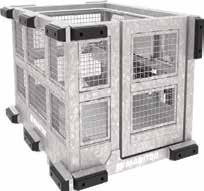

• Driving & service information
• Onboard diagnostics

MANITOU SOUTHERN AFRICA

Tel: +27 10 601 3000
Email: info.msa@manitou-group.com

www.manitou.com

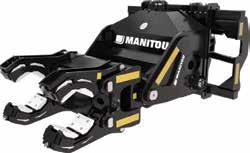
Represented throughout the African continent through our network of dealers.

ADMINISTERS A MASSIVE MOVE MAMMOET

South Africa currently faces a wide range of infrastructure challenges, including fragile road surfaces and a growing number of potholes. These issues pose challenges to the average road user who drives a car, so one can only imagine the di iculties created for mines that need to transport massive pieces of equipment to remote regions.
This was the challenge faced by heavy li ing and transport company Mammoet, when a face shovel excavator had to be moved from the Kromdraai Colliery in Mpumalanga to a new cut in nearby Emalahleni.
The 552t Terex O&K RH340 face shovel machine is, in fact, a tracked vehicle that is capable of crawling between di erent cuts on a single site, by itself. However, such machines are not capable of crawling any great distances – such as between sites, and they are certainly not meant for public roads.
However, the company points out that with some 75% of South Africa’s energy needs still directly reliant on coal mining, when a new site is opened, it becomes necessary to ensure that key equipment is mobilised as quickly and e iciently as possible.


To achieve this, and to enable transportation, Mammoet had to split the machine into two primary segments. The first section was the 291.5t main machine, with the second segment being the 207.9t undercarriage.

The company chose to use its preferred four-point li ing system methodology for the splitting procedure, as this approach o ers increased stability compared to crane-based approaches, and was less susceptible to sourcing issues.
Following the decoupling of the two sections of the excavator, the main machine was attached to the four-point li ing system. Mammoet raised this to a total height of 8.1m, which in turn provided the requisite clearance for the tracks. Being self-propulsive, these were then simply driven out from underneath the suspended main machine.
A Goldhofer THP/SL 22-axle trailer was deployed for this project, to help facilitate the move. A massive piece of equipment in itself, with a length of some 37.8m and a width of 4.3m, along with an axle spacing of 1.8m, it was chosen for the simple reason that smaller trailers would
not have been able to cross over the critical bridge structures on the 25.4km route.
Much planning and measurement was required before the operation was begun. Apart from checking ground pressure, the entire route was analysed beforehand, to ensure that during transport, the machine’s vertical radii didn’t exceed the navigable parameters of the 77.1m-long convoy.
In addition, discussions were held with a local steel smelting plant in order to make an arrangement for certain high-voltage power lines to be disabled for a brief period, allowing the convoy to pass safely.
At the Emalahleni site, Mammoet staged the main machine o onto four stools lined by two 7m header beams, at a height of 1.6m. Following the same process again for the transport of the undercarriage, including using the same four-point li ing system to a clearance of 1.63m, the second half of the machine was transported to the new site.
Once the undercarriage was manoeuvred underneath the waiting main machine, the face shovel was reattached, and – despite its tricky journey across fragile, potholed roads – the excavator could quickly be put to work once again at the new site.
www.samining.co.za 34 SA MINING SEPTEMBER / OCTOBER 2023 MINING EQUIPMENT
© ISTOCK –
Moving hundreds of tonnes of mining equipment from one site to another requires careful planning and analysis to avoid the signifi cant road challenges that are part of daily life in SA
sirene68
SCANIA SOUTHERN AFRICA PLANTS A FOREST








Scania Southern Africa is planting a forest as a way to help drive the shi to more sustainable transport solutions. The company’s sustainable transport solutions include low-emission Euro 5 vehicles, the soon-to-be-launched Scania Super with Euro 6 engines, natural gas vehicles and zeroemission Scania battery electric vehicles.
According to Scania, the trees will be planted in areas where they can have the most impact. Many communities in South Africa lack green spaces, and yet research links trees to a reduction in crime, better school performance and improved health benefits. Therefore, every tree planted in a Scania Sustainability Pioneer’s name will create a healthy and sustainable community ecosystem, while ensuring these business visionaries are forever a part of the environment they are helping Scania to protect.
“Considering that our roads carry more than 70% of all goods transported across South Africa, ensuring the e ects of climate change are drastically reduced is a pressing responsibility,” says Erik Bergvall, MD, Scania Southern Africa.

He notes that as the first heavy commercial vehicle manufacturer to set science-based targets aligned to the Paris Agreement, Scania is, together with its sustainably minded customers, taking collective ownership of their role in climate change.

“Already our science-based targets aim to ensure our vehicles produced in 2025 will emit 20% less carbon emissions than those produced in 2015,” says Bergvall. “To further increase e iciencies, we have introduced optimised vehicle specifications that include better powertrains and further fuel e iciencies.”
When fossil fuels like diesel burn, they release carbon dioxide, which becomes trapped in the atmosphere, causing temperatures to rise and leading to climate change. The transport sector is particularly exposed and vulnerable to impacts of natural disasters, meaning climate change is expected to exacerbate future risks.
Pioneers, we are working together to reduce the carbon emissions necessary to limit climate change in Southern Africa.”
Sustainable transport solutions o er transport operators a competitive advantage. Many companies have climate-related targets and are looking across their supply chains for opportunities to reduce carbon emissions. A fleet that includes sustainable transport solutions could soon become a factor to enable transport operators to win in a competitive bid.
“By di erentiating as a transport operator, with a distinct focus on people and the planet, your company engages with a sense of purpose and could attract a new customer base who prefers to do business with sustainably minded suppliers.”
The costs of inaction are steep, especially if carbon emissions continue to rise. Resilient transport interventions can significantly help to reduce future losses across the transport sector.

Remember


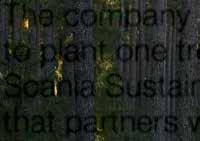
COLLECTIVE EFFORT
“The shi to sustainable transport solutions is a collective e ort – we can’t do it alone. By partnering with our Scania Sustainability
“At Scania, we measure the climate impact from our vehicles using operational data from all our globally connected trucks and buses. This commitment to a transparent process of tracking emissions ensures Scania and its visionary customers can play a leadership role in combatting climate change.
“We look forward to growing our Scania Southern Africa Sustainable Forest, with each tree a symbol of the on-the-ground partnership we have with our visionary customers.
“By managing their operations with less climate impact than their competitors, they are paving the way for a new and sustainable transport system across Southern Africa. This is a shi that promises to deliver long-term benefits for the transport industry, society and the environment,” says Bergvall.
www.samining.co.za SA MINING SEPTEMBER / OCTOBER 2023 35 TRANSPORT CORPORATE PROFILE
The company has promised to plant one tree for every Scania Sustainability Pioneer that partners with it to drive the shift to a sustainable transport system
that extreme weather may disrupt and damage the vital connections that provide access to economic opportunities, healthcare, education and social connections. In SA, transport has been identified as the fastest growing source of greenhouse emissions, accounting for 10.8% of national GHG emissions. Direct emissions from the road sector account for 91.2%.
The shi to sustainable transport solutions is a collective e ort – we can’t do it alone.
ENGINEERING DESIGN AND ITS ALL-IMPORTANT ROLE IN MMM
Engineering design has become a vital component in multiple industry segments, including mining, minerals and metals (MMM). This is due to the industry moving into the age of robotic process automation (RPA), artificial intelligence (AI) and the internet of things (IoT), with connected devices transmitting from the field to cloud environments.
Augmented reality (AR) and virtual reality (VR) are also making an impact in the mining industry, improving safety, e iciency, and productivity. For example, VR is used to create virtual simulations optimised for training and analysing changes at mining sites, whereas AR o ers important remote support to workers in hazardous areas.
It is an exciting and innovative age that places engineering design at the forefront, meeting the requirements of an increasingly sophisticated marketplace – a new dawn indeed.

From a practical point of view, engineering design o ers three important benefits to the mining industry:
SAFETY AND RISK MITIGATION
This includes mining operation layout, ventilation systems, and support structures to ensure the safety of workers and minimise the risk of accidents. Engineers design safety protocols, implement hazard controls, and develop emergency response plans to mitigate potential risks associated with mining activities, such as collapses, gas emissions and equipment failures.
EFFICIENT EXTRACTION AND PROCESSING
By Johan Potgieter
Cluster Software Lead at Schneider Electric



impact of mining activities, including measures for dust control, water management and waste management.
Furthermore, they are developing strategies for land rehabilitation and reclamation to restore mined areas to their natural state. Additionally, engineering design incorporates sustainable practices such as energy-e icient equipment, water recycling systems, and the use of renewable energy sources to reduce the carbon footprint of mining operations.
THE COMPETITIVE ADVANTAGE
Apart from the daily and tangible benefits that come with advancement in engineering design, it also o ers MMM players a competitive advantage in a cutthroat industry.
For one, engineering design is a core component of economic development, and South African business is heavily invested in the importance of staying competitive in the global marketplace.

Engineering design plays a key role here, as it enables companies to create highquality, innovative products that can compete e ectively on an international scale. Ultimately, by investing in technology design capabilities, MMM players can increase their competitiveness and expand their market reach.
Engineering design plays a crucial role in optimising the extraction and processing of mineral resources. Here, engineers design e icient mining methods and equipment to extract minerals e ectively, while minimising environmental impact. This includes the design for blasting techniques, drilling patterns, and material handling systems.
In mineral processing plants, engineers aim to design e icient equipment – such as crushers, mills, and separators – all to maximise the recovery of valuable minerals from ore and minimise waste.
ENVIRONMENTAL STEWARDSHIP
Engineering design in the South African mining industry also focuses on environmental stewardship and sustainability. Engineers are working hard to design systems that minimise the environmental
Rapid technological advancement has created opportunities for companies to use engineering design for product development and optimisation. Technologies such as AI and IoT have the potential to revolutionise various industries. South African companies are taking advantage of these technologies and leveraging their engineering designs to reap the benefits.
South Africa has a wealth of skilled engineers and designers, and companies recognise the value of leveraging this talent. The country is placing increasing emphasis on promoting technical skills and developing design skills. By investing in technology design, companies can tap into this talent pool and take advantage of locally available expertise.
In summary, the MMM industry, like many of its peers, is using engineering design to stimulate growth, competitiveness, technological progress, infrastructure development, available skills and expertise, and commit to sustainability.
Ultimately, strong and e ective engineering design enables MMM players to drive innovation, enhance operations and strongly position themselves in a highly competitive marketplace.
COLUMN ENGINEERING
© ISTOCK –gorodenko
The views expressed are the author’s own and do not necessarily reflect SA Mining’s editorial policy.
In a digitally transforming world, engineering design is becoming increasingly vital to those mining organisations seeking to stay ahead of the game
“
www.samining.co.za 36 SA MINING SEPTEMBER / OCTOBER 2023
Apart from the daily and tangible benefits that come with advancement in engineering design, it also o ers MMM players a competitive advantage in a cutthroat industry.
“





Q&A WITH MURRAY MACNAB

Executive Technical Director


Sha sinking is a complex and at times risky – but very necessary –aspect of the mining industry. SA Mining spoke to specialists UMS to delve a little deeper into the risks and challenges faced by this part of the sector.


Q: WHAT ARE CONSIDERED THE FOUR HIGHEST RISKS RELATED TO VERTICAL SHAFT SINKING?
A: Historically, sha sinking has a poor reputation, partly due to the practices of old. At UMS, we have systematically gone about identifying, assessing, and then eliminating all major risks as far as possible. Residual risks are then mitigated through continuous improvement interventions.
Every safety incident that occurs, no matter how small, is thoroughly investigated and corrective action is taken. All lessons learnt are recorded and operating procedures are updated to include these. Our point is that, when done correctly, sinking a sha should be no riskier than working in an o ice. Nonetheless, the four most obvious risks are:
1. Gravity/falling objects from a height: Anything falling down a sha is a hazard to the people on the Galloway/stage and sha bottom.

2. Moving machinery in a confined space: For example, hoists, lashing gear, drilling rigs and other mechanised machinery.
3. Confined spaces: There is precious little room on the Galloway and sha bottom for the sinking crews.
4. Environmental condition: These may include gases, flooding, heat, ventilation and noise.
Q: WHAT ARE THE MOST COMMON APPROACHES TO OVERCOMING THESE PARTICULAR CHALLENGES?
A: Firstly, it is important to mechanise as far as possible and to reduce the number of

people working below the collar. This is done through mechanisation and automation, with UMS typically reducing personnel numbers here from over 300 to 50 or fewer. Secondly it is also important to address the above four points by engineering out the hazards during the design phase. The third and final line of defence is personal protective equipment (PPE).
over 60 years of experience to prevent any repeat accidents. All this has resulted in us being able to use teams around one sixth the size of the sha sinking teams that were traditionally employed on a project in the 1980s.
More recently, UMS has formed a partnership that will see cutting-edge industrial internet of things and augmented reality technology being applied to the conceptualisation, design, construction and operational management of mining projects and mining operations.
Q: DOES YOUR ORGANISATION HAVE ANY UNIQUE APPROACHES OR ADVANCED SOLUTIONS TO REDUCE OR ELIMINATE THE DANGERS?
A: We have engaged with original equipment manufacturer suppliers on drill rigs and mucking equipment to improve safety features. We have added safety features that were missing, improved ergonomics to eliminate fatigue, and reduced noise levels and heat generation to improve safety. UMS has also challenged its own engineering and design experts to eliminate risks on Galloway/stage designs through mechanisation and automating of past manual tasks. Signals and lights in the Galloway warn personnel of moving machinery and warn of the direction of travel, while interlocks prevent man/ machinery interfaces.
The hoist safety systems related to sha sinking are in-house designs that are specific to our requirements, designed with
Technology collects and analyses data that is generated automatically from sensors on plant and equipment or entered manually. This information can be displayed on dashboards or live video feeds, o ering a visualisation of operational performance and status by area or by the entire mine. These solutions provide managers with accurate, predictive and actionable real-time data, and information of a quality that has never really been available before in mining.
Moreover, it is designed to be adapted so that when we hand over the sha , it will provide the operational team with relevant production information, thereby ensuring safety is carried over from the sinking process to mining operations.
Q: LOOKING AT THE EFFORTS MADE IN THIS FIELD, WHAT IS YOUR VIEW OF THE NEAR TO MEDIUM TERM FOR THOSE INVOLVED IN SHAFT SINKING?
A: For the near to medium term, conventional sha sinking such as blind sha sinking and sliping has a permanent place in the sha sinking industry. This conventional approach is still the fastest and most economical way of sinking a sha . This is the reason UMS is working hard to perfect the methodology, while focusing on safety and productivity so that e iciencies and speed can be increased, without compromising safety.
www.samining.co.za 38 SA MINING SEPTEMBER / OCTOBER 2023 SHAFT SINKING
UMS Group
Murray Macnab.
© ISTOCK –Marc_Osborne

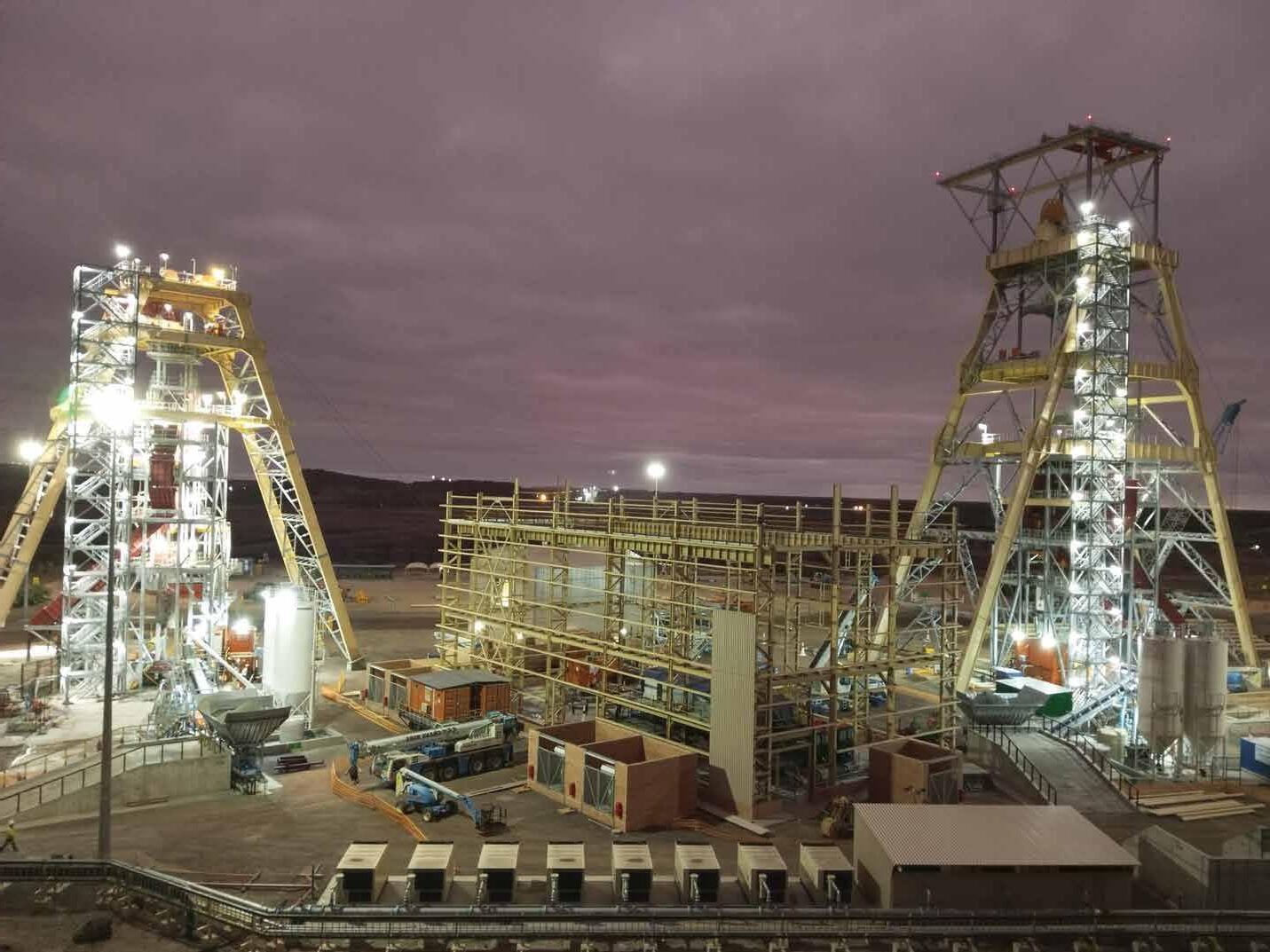
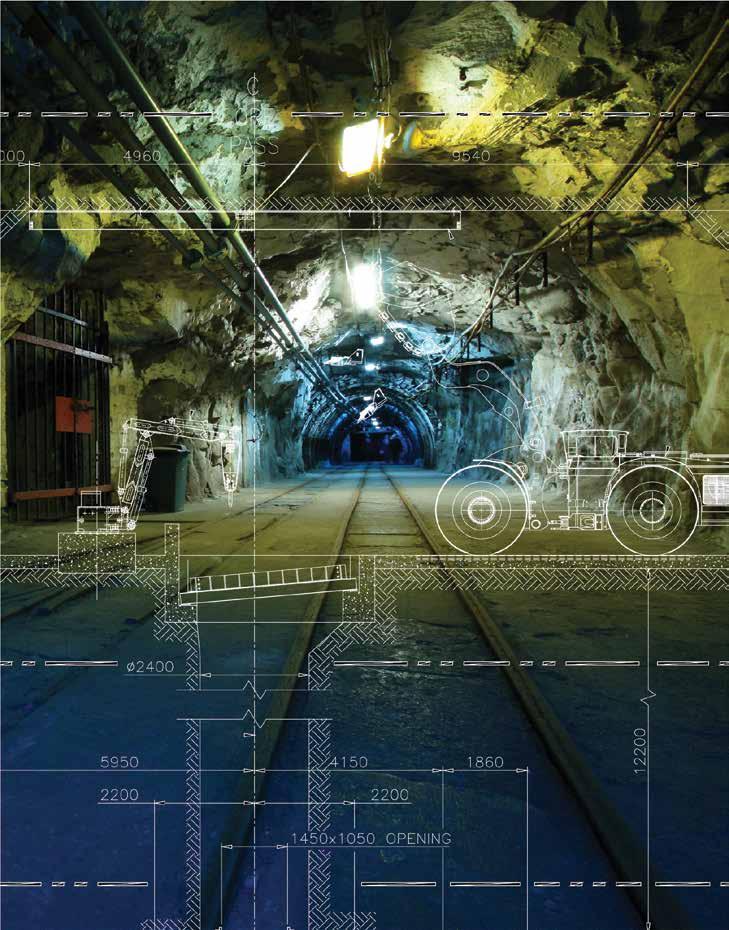
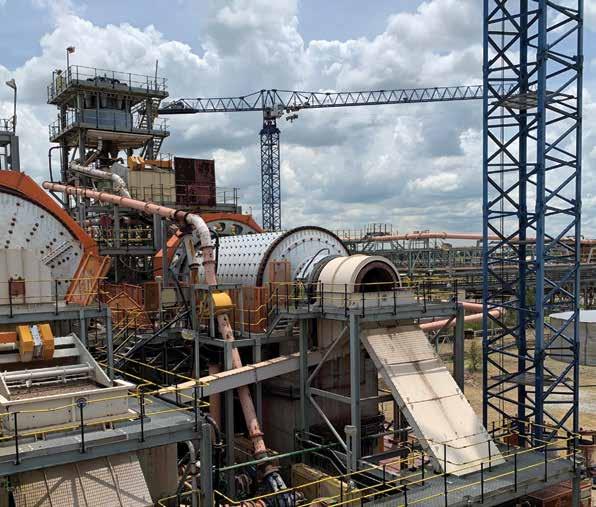
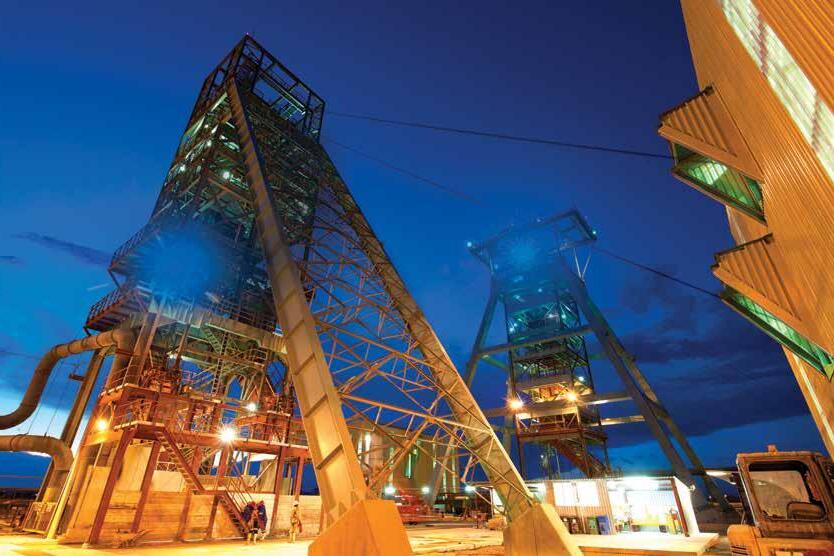
UMS GROUP Providing specialist professional design & engineering, contracting as well as project support and management services to the global mining and metallurgical processing industry. UNITED MINING SERVICES GROUP UMS Ground Floor, Building 12 | Woodlands Office Park 20 Woodlands Drive | Woodmead Johannesburg | 2191 | South Africa Call Center +27 (0)11 445 4300 E-mail info@umsint.com Web www.umsint.com UMS has regional offices in the United Kingdom; USA (Nevada); Botswana; Brazil
EMBRACING THE GENERATIVE AI ERA FOR MINING

Everyone is talking about artificial intelligence (AI), and whether it spells a new future for business and industry, or whether it is going to destroy jobs and – ultimately –the world.
Despite the fears of science-fiction writers around the globe, the latter is unlikely to occur, but as for the benefits AI (and in particular generative AI, which is similar to ChatGPT) can o er, sectors like mining will benefit enormously from implementing this new technology judiciously.
According to Nishal Nair, Industry X lead for Accenture in Africa, the power of generative AI comes from unsupervised learning techniques. This means that based on the prompt it is given, it will independently create new contextual data that can easily be interpreted and applied across a mine’s value chain, from exploration through to delivery of the final product.
“The applications for generative AI in mining begin with exploration. Here geologists need to identify new deposits of minerals, in what is a data-intensive exercise, with the data appearing in multiple formats too. Generative AI helps fill in gaps in the data and enables the user to make sense of the information with limited need for manual interpolation and extrapolation of the data,” he says.

“It can also assist with sub-surface modelling – which has similar issues around di erent sources of data and its levels of completeness – enabling the mine to produce 3D subsurface models of the distribution of the deposit. This allows mining engineers to develop a mine plan to extract these more e iciently.”
Nair adds that with the drilling and blasting required for extraction and processing, generative AI is perfect for developing e icient drill and blast plans, as it helps you understand the overall geological conditions better.

predict potential failures and implement proactive maintenance, which can thus be undertaken in a planned manner, and is far less costly than unplanned downtime.
“Then of course, with underground mining, we have an inherently dangerous environment, threatened by rockfalls and unexpected cavities. Since any accident here will lead to a halt in production, a negative emotional impact on employees and even potential loss of life, generative AI can really contribute to safety,” he says.
Generative AI can be used e ectively to leverage geological, operational and heavy machinery data, pulling this together to predict with accuracy where there are potential dangers. This means mines can adjust their plans to avoid proximity to these danger zones and keep their employees safer.
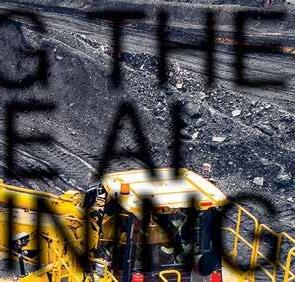

“With an optimal drill and blast plan in hand, it means you can find the right areas with the best access to the ore, speeding up the process, reducing the waste and making the downstream processing less costly, as it is more e icient and less intensive.
“The same goes for material stockpiles. With the insights provided by generative AI into the contents of the pile, you will have a clearer understanding of the ore properties that reside within, allowing for better blending decisions and downstream processing, to increase throughput.”
He says it even assists with regard to asset management, enabling one to

“While there are many AI technology opportunities to exploit, there are also any number of threats that can impact an organisation. To this end, we recommend businesses first consider the guardrails they need in place to prevent finding themselves on the wrong side of the rules – much like plagiarism concerns continue to swirl around the use of ChatGPT.
“From an Accenture point of view, we help mining companies to navigate the implementation and use of this new technology, and ensure it is fine-tuned to the specifics of the individual organisation.
“We see our role as helping mines to overcome the uncertainty that exists around the use of such technology, so that they can adopt generative AI in a responsible and value-adding way into their business,” says Nair.
www.samining.co.za 40 SA MINING SEPTEMBER / OCTOBER 2023 TECHNOLOGY CORPORATE PROFILE
© ISTOCK –agnormark
The potential offered by new technologies like AI is such that the effective use of these solutions can positively impact all areas of the mine, according to Accenture
“ “
Generative AI can be used e ectively to leverage geological, operational and heavy machinery data, pulling this together to predict with accuracy where there are potential dangers.
Safe, Smart and Sustainable Solutions

We help mining companies transform their mine operations – extracting value through innovation, best talent and technology.
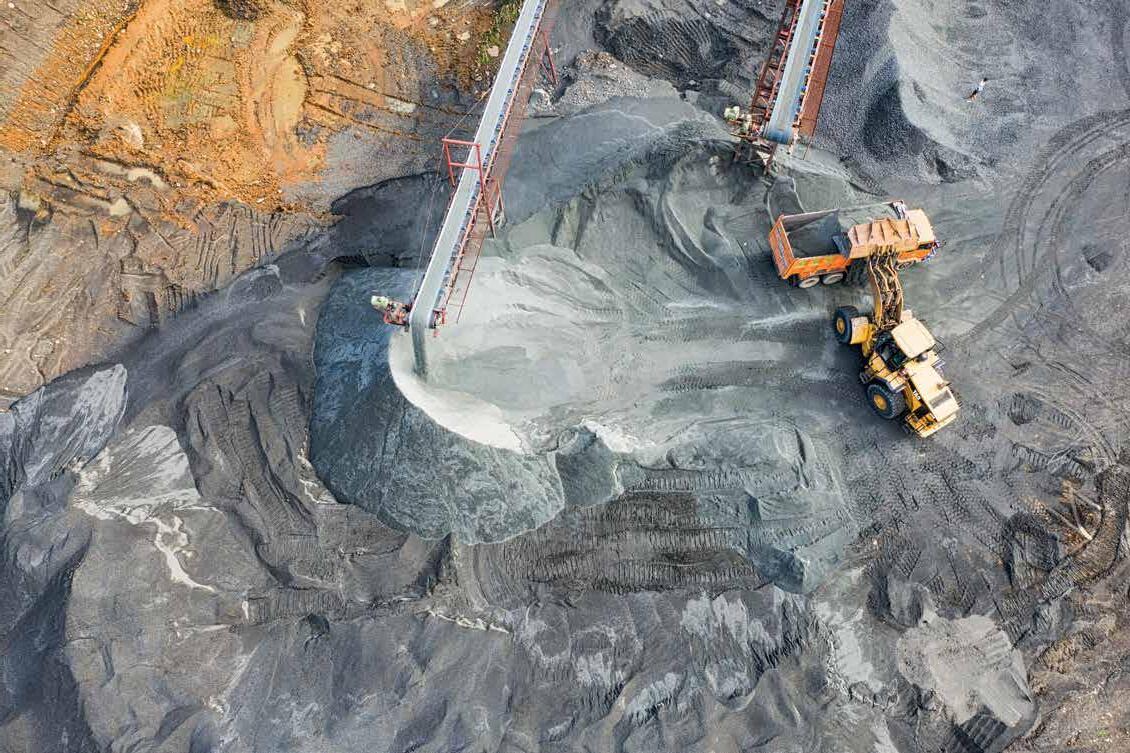

TIME TO ELEVATE THE INDUSTRY
AT THE JOBURG INDABA
The 2023 Joburg Indaba, which will be the 11th such event, is set to take place on 4 and 5 October at the Inanda Club, Sandton. With key stakeholders across the industry represented, along with government and investors, frank, open and honest discussions around the current state of the mining sector are expected.
More crucially, the Indaba will afford all stakeholders the opportunity to discuss how they can work together to ensure the industry grasps the opportunities of the future, and contributes to the country’s economic growth.
These open and informed talks are the heart of the Joburg Indaba. Industry leaders, policymakers, investors, and key players convene to deliberate on the pressing issues confronting mining. These exchanges empower participants to make informed decisions, ultimately steering the sector towards favourable outcomes.
One of the hallmarks of the Joburg Indaba is its ability to inspire collaboration by transcending individual company interests to involve government agencies, industry associations and investors. Through robust conversations, these stakeholders come together to discuss challenges, differences and mutual interests. The event’s “hot pot” of perspectives and expertise becomes a platform for problem-solving and idea generation.
Transparency and constructive dialogue at the Joburg Indaba also play a pivotal role, as the industry takes a proactive approach to addressing its challenges and encouraging collaboration and trust among stakeholders.
The Joburg Indaba stands as a hub for knowledge exchange among industry experts. This dissemination of knowledge
contributes to the development of a more sustainable and responsible mining sector, and visitors can expect a highly engaging and interactive two days.
A GLIMPSE INTO THIS YEAR’S AGENDA
The event promises to address a diverse array of pivotal issues shaping the mining landscape, as we find out how the industry is managing key pressure points, and how investors are currently going about their investment decisions.
Topics will include geopolitical and macroeconomic developments, collaboration between industry and government, the energy transition and the realm of critical metals and minerals, and innovation and digital transformation. They will also include environmental, social and corporate governance considerations, energy supply security, and decarbonisation efforts within mining operations, among others.
Participants will have the opportunity to explore:
■ The mining industry’s role as a driver of development, innovation, and change in the global economy.
■ Collaborative endeavours between government and businesses, to enhance
South Africa’s investment appeal, focusing on initiatives like the National Logistics Crisis Committee, Joint Initiative to Fight Crime and Corruption, and National Energy Crisis Committee.
■ Regional solutions stemming from cooperation among mining companies.

■ Sustainable and responsible mining practices, emphasising environmental and social responsibility.
■ The future of coal in the energy transition, emphasising cleaner practices and transition strategies.
■ Strengthening partnerships among mining companies, communities, and the workforce.
■ Positioning the mining industry at the forefront of cutting-edge technologies and digital transformation.
This event follows on the successes of the Cape Town Indaba and the Junior Indaba. The Joburg Indaba is expected to continue being an influential platform, where the mining industry’s collective wisdom and vision converge, propelling it towards a future of sustainable growth, innovation, and societal responsibility.
www.samining.co.za 42 SA MINING SEPTEMBER / OCTOBER 2023 AFRICA CORPORATE PROFILE
© ISTOCK –NexTser
The Joburg Indaba will provide a platform for mining stakeholders to tackle challenges, unearth opportunities, and develop solutions that elevate the industry

MINERAL TECHNOLOGIES. Innovative WIRTGEN surface miners, robust KLEEMANN impact crushers and screens plus customized services make the WIRTGEN GROUP a reliable partner for all mining applications. Take advantage of innovative solutions from the technology leader. WIRTGEN SOUTH AFRICA (Pty) Ltd . 52 Maple Street . Pomona . Kempton Park 1619 . South Africa T: +27 11 452 1838 www.wirtgen-group.com/southafrica Powerful! CLOSE TO OUR CUSTOMERS A JOHN DEERE COMPANY www.wirtgen-group.com/mineral
ADDRESSING THE GROWING THREAT OF SUBSTANCE ABUSE IN MINING OPERATIONS



Mining companies face significant safety risks associated with the use of nyaope and cannabis among employees, jeopardising both the wellbeing of workers and the overall safety of operations. These substances can severely impair users’ ability to concentrate, posing challenges to maintaining focus during work.
To ensure the safety of mineworkers, minimise incidents of injury, and maximise productivity, mining companies should consider adopting saliva testing as a more suitable method of screening. Saliva testing o ers shorter detection periods, indicating recent usage, when compared to urine testing. Its sample collection process is also less invasive, making employees more willing to comply with testing requirements.
By Rhys Evans Managing Director at ALCO-Safe

Furthermore, drugs can be detected in saliva within minutes of use, enabling quicker identification compared to urine samples, which may take up to 72 hours to reveal drug presence. Embracing saliva testing can e ectively accelerate the detection of drug use among mine employees, promoting a safer work environment.
DANGEROUS SUBSTANCES
Nyaope and cannabis are both drugs that can have a significant impact on a person’s ability to work safely and e ectively. Nyaope is a dangerous and highly addictive drug that is made from a mixture of heroin, rat poison, and other substances. Worryingly, nyaope is increasingly mixed and sold with cannabis, o en without the user’s knowledge. This can result in addiction, and can cause a number of health complications, including respiratory and heart problems as well as mental health problems.
Nyaope can also impair a person’s judgement and coordination, which can lead to accidents and injuries in the workplace. A great concern surrounding nyaope is the fact that it can create a culture of addiction among mine employees as they share the experience of smoking the substance. Furthermore, due to its harsh nature, the a er-e ect of the drug is so intense that it o en leads to violent and aggressive tendencies among users – leading to an even more unsafe working environment.
While cannabis is a less dangerous drug than nyaope, it can still impair a person’s ability to work safely and e ectively as it can cause drowsiness, impaired judgement, and slowed reaction time. These e ects can make it di icult for people to operate machinery or equipment safely, and can increase the risk of accidents and injuries. In addition to the physical dangers, the use of nyaope and cannabis in the workplace can also lead to several other problems. These include decreased morale and productivity, increased absenteeism, and sta turnover.
There are several steps that mining organisations can take to
stem the use of drugs in the industry, such as implementing regular drug testing programmes. To achieve this, mines need to implement a strategy of testing a set number or percentage of employees per day. This method will have a much stronger and more successful deterrent e ect, as word spreads through the workforce of the likelihood of being tested – helping prevent unnecessary accidents and injuries, while aiming to improve productivity and morale.
To ensure that testing programmes are not perceived as having a purely disciplinary purpose, mining organisations should o er employee awareness and assistance programmes. These must educate workers on the dangers associated with substance abuse and provide support to those struggling with addiction through counselling, support groups, and other resources to get the treatment they need.
Through awareness and testing, mining companies can establish a drug-free workplace culture by educating employees about the dangers of drugs and setting clear expectations for drug use through a written workplace substance policy. This can help discourage employees from using drugs in the first place. It is also important for mining organisations to work closely with unions and other stakeholders in the development and implementation of drug prevention programmes. This can help to ensure that all employees are aware of the dangers of drugs and that they have access to the resources they need to get help.
ADVANCEMENTS IN TESTING TECHNOLOGY
For the purposes of saliva testing, disposable multi-panel tests are no longer the only option. Today, mining organisations should be investing in a SoToxa Mobile Test System, designed for rapid drug screening and detection in oral fluid. This handheld analyser can detect the presence of six kinds of drugs: cocaine, methamphetamine, opiates, cannabis (THC), amphetamine and benzodiazepines.
One of the major benefits associated with this system is its reporting functionality, which can be filtered by various factors such as age group and gender. This can be used to assess progress in the establishment of a drug-free workplace and measure the e ectiveness of workplace interventions over time.
It is important to remember that drug testing is not a perfect solution, but is an important tool that can help to reduce the use of drugs in the workplace. It should be used in conjunction with other measures, such as employee assistance programmes, to create a drugfree workplace culture.
Furthermore, drug testing should be fair and consistent, and should always be conducted in a way that respects the privacy of employees. By taking such steps, mining companies can help to create a safe and productive workplace for sta .
COLUMN SAFETY
© ISTOCK –Bilanol
The views expressed are the author’s own and do not necessarily reflect SA Mining’s editorial policy.
Mines face potentially signifi cant safety risks related to employees’ use of nyaope and cannabis, something that can jeopardise both their wellbeing and operational safety
www.samining.co.za 44 SA MINING SEPTEMBER / OCTOBER 2023

YE A RS O F PROG RE SS IN A FRI CAN MININ G 30 5-8 February 2024CTICC, Cape Town, South Africa @miningindaba | #MI 24 | mi ning i ndaba .co m Jo in u s t o ce le brate the 3 0 th anni ver sa r y o f I nve sting i n A fri c an Mining Indaba n ex t y ea r. Register now to be part of the landmark event. REG I S T ER NOW
CELE BRATE
AECI COMMISSIONS SOLAR ENERGY INSTALLATION
In line with AECI’s objective to reduce electricity supply risks and prioritise renewable energy alternatives, the company has installed and commissioned a 1MW solar project at Chem Park, its AECI Chemicals manufacturing site in Johannesburg.

The Chem Park project marks the first stage of a four-phase solar programme approved by the AECI executive committee in 2021. Ultimately, 14.3MW per annum of solar-powered electricity will be generated at selected AECI operating sites in South Africa.
The project is in line with AECI’s environmental, social and governance and broader sustainability targets, which include reducing its reliance on fossil fuels and limiting its carbon footprint. In addition, these initiatives strengthen the company’s ability to supply product and services to its customers in South Africa.
Another two renewable energy installations are scheduled for commissioning within the first quarter of 2024 at major production facilities. AECI Mining Chemicals in Sasolburg is scheduled to bring 1.5MW online, while AECI Mining Explosives in Modderfontein will commission 4MW of energy supply.
“Both sites play key roles in our country’s mining sector value chain. The decrease in the use of fossil fuels contributes to the positive effect on the overall carbon footprint of this industry,” says Holger Riemensperger, AECI chief executive.
“Climate change is one of the most complex and pressing issues facing humanity today and global understanding of the phenomenon continues to evolve. It is critical that businesses devise appropriate response strategies. AECI therefore remains committed to pursuing a greener business footprint and delivering sustainable solutions for a better world,” he says.

MAKING MINES WORK





















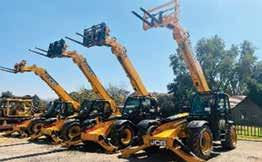

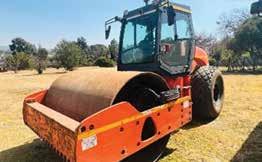




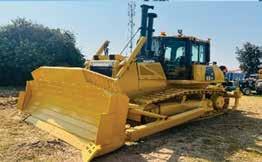
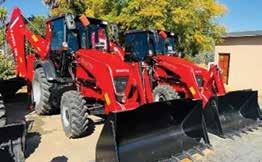



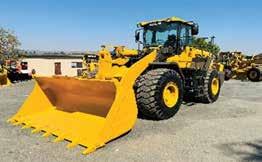






www.associatedequipment.co.za Duncan: +27 (0) 83 626 5588 Anton: +27 (0) 82 923 5397 Jaap: +27 (0) 82 892 1327 Loraine: +27 (0) 76 021 4344 Office: +27 (0) 11 801 4911 vendels@mweb co.za associatedloraine@xnet.co.za ves@xnet.co.za Plot 92 Indaba Lane-off Beyers Naude, Rietfontein, Roodepoort, South Africa We Are Buyers For Your Good Running Redundant Equipment GPS COORDINATES: S26°3”56.343 – E37°52”37.453 • www.vendelequipmentsales.co.za 1x 2018 Volvo EXC750 DL Excavator Fully Refurbished (75Ton) 1x 2013 CAT 349D2L Excavator 1x 2006 Hyundai Robex 500LC-7 Excavator (Still In Workshop) 1x 2019 JCB 535-125 Telehandler 1x 2019 JCB 540-140 Telehandler 6x2017-2019 JCB 540-140 Telehandlers 1x 2017 JCB 540-170 Telehandler 2x Etnyre K Chip Spreaders 4x2 Fixed Hopper-Refurbished 1x 2008 CAT AP600 Asphalt Paver 1x 2005 HAMM 3414 SD Roller 1x 2014 Wacker RD12 Sit On Roller 2x New 2022 CASE 770FX Series 4x4 TLB 3x New 2023 CASE 770EX Series 4x4 TLB 1x 1997 CAT 428C 4x2 TLB 1x1997 CAT D10R Dozer-Full Rebuilt 1x2011 CAT D8R Dozer-Full Rebuilt 1x2008 CAT 824H Wheel Dozer 1x 2016 Komatsu D375-6 Dozer (Still In Workshop) 1x 2005 CAT 16H Motor Grader With RipperRefurbished (Engine Rebuilt) 2x 1994/87 CAT 140G Motor Graders with Rippers 4x 2012 Volvo A35F 6x6 ADT’s 1x2006 BELL B50D 6x6 ADT 1x 2004 Terex TA30 ADT 1x 2014 Komatsu D65EX-16 Dozer -Refurbished 1x 2008 Komatsu D375-5 Dozer 2x New 2022 Manitou MBL745 HT 4x4 TLB’s 1x2007 Barford SX3300 Concrete Dumper 2x New 2023 CAT 323D3 Excavator’s 1x New 2021 CAT 320D3 Excavator Piped For Hammer 1x 2013 CAT 349D2L Excavator (50Ton) 1x 2021 CAT 320D3 Excavator 1x 2008/07/01/97 CAT 140H Motor Graders with Rippers 1x 1983 CAT 16G Motor Grader 1x 1984 CAT 14G Motor Grader 3x 2018 Doosan DA40 ADT’s 6x6 2x 2012/10 CAT 740 ADT’s 6x6-Refurbished 1x NEW 2022 SDLG L956F F.E.L 1x 2016 Liu Gong ZL50CNX F.E.L 1x 2016 Rondebult ZL50 F.E.L 1x New 2023 JCB 3DX Plus 4x4 TLB’s w ith 6:1 Bucket 1x 2014 Wacker RD12A Sit On Roller2 1x 2021 CAT 320D3 Exc (Only 2000 Hrs) 1x 2022 CAT 323D3 Exc (Only 2000 Hrs) 1x2021 Volvo EC210 Exc (Only 1800Hrs) 1x 2012 CAT 140K Motor Grader with RipperFully Refurbished 1x 2014 CAT 140K Motor Grader With Ripper 1x 2007 CAT PF300C 7 Wheel PTR 1x 2008 HAMM GRW15 PTR 1x 2003 HAMM GRW18 PTR 1x 2013 Powerstar VX4035 Twinsteer 18000 Lt Water Tanker 1xMercedes Axor 18000 Lt Water Tanker 2x 2014 CAT 986H FEL’s-Refurbished 1x 2008 Komatsu WA430 FEL 1x NEW 2022 SDLG L956F F.E.L
APPLICATIONS
• Nip Guards improve worker safety around head, tail, and drive pulleys and prevents worker exposure to conveyor pulley nip points and pinch point hazards.

FEATURES
• Easy installa�on.
• Low maintenance.
• Simple design.

• Operates in all condi�ons.






• Manufactured according to SABS, CEMA, Australian and PROK moun�ng standards.





• Unique adjustable guard maintains a constant gap between the conveyor belt and guard, even when the conveyor belt is tensioned.

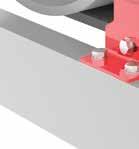

• Robust construc�on for longer life.
• Can be installed on bi-direc�onal conveyor belts.








Tel : +27 11 013 4000 Fax : +27 11 013 4150 E-Mail : sales@brelko.com Website : www.brelko.com BRELKO NIP GUARD SAFETY DEVICE PATENTED NEW PRODUCT BRELKO CONVEYOR PRODUCTS ® SERVICEEXCEL L ECNE 35 OVER YEARS Adelaide Ruiters Mining and Exploration (Pty) Ltd (A.R.M.E) ........... 29 Accenture South Africa ................................................................. 40-41 AECI Mining Explosives OBC Bara Consulting 23 BLC Plant Company IBC Brelko Conveyor Products 48 ENSafrica 16-18 Envass 26-27 Fuchs Lubricants ............................................................................... 46 Invincible Valves................................................................................... 7 JA Engineering Works (Pty) Ltd 8-10 Komatsu Mining 11 KSB Pumps & Valves 25 M84 Geotech 30 Manitou 33 NSDV 13 Pathogen & Environmental Solutions (Pty) Ltd ................................. 21 Pratley ................................................................................................ 37 Structa Group (Prestank) 32 Scania 3 Toyota Hino Trucks 5 UMS 39 Vendel Equipment Sales 47 VME Group IFC Wirtgen ............................................................................................... 43 INDEX TO ADVERTISERS © ISTOCK –Nordroden TO ADVERTISE IN ADVERTISING Ilonka Moolman 011 280 3120 moolmani@samining.co.za Tshepo Monyamane 011 280 3110 tshepom@samining.co.za MIN NG READ WHAT REALLY GOES DOWN IN SADC SA www.samining.co.za WATCH: Business Spotlight – Enaex Africa’s plans to embrace artificial intelligence IN CASE YOU MISSED OUR INTERVIEW! Gary Alfonso speaks to CEO of Enaex Africa, Francisco Baudrand, about the company’s plans to embrace artificial intelligence, while also looking into incorporating sustainability within the organisation’s strategic objective. https://youtu.be/2U0RMa_6bko



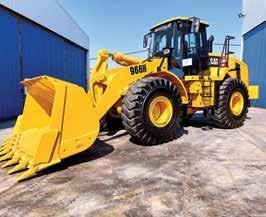



MAHINDRA MAYHEM BRAND NEW MAHINDRA VX90 4X4 TLB’S with AIRCON PARTS RENTAL PLANT AFRICA’S LEADING EARTHMOVING EQUIPMENT & PARTS DEALER www.blcplant.com +27 11 555 2000 info@blcplant.com Service exchange units available. 6 MONTHS WARRANTEE on refurbished components. View all our available stock on our website www.blcplant.com WHEEL LOADER CAT 950H; 966H/L; 962H; 980H; 992G/K EXCAVATOR CAT 320D; 323D; 329D; 336D; 345D; 349D; 374D/F; 390D/F MOTOR GRADER CAT 140H; 140K; 14H DOZER CAT D6R/T; D7R; D8R; D9T; D10T; D11T OVER 600 MACHINES IN STOCK CAT 740’S
BETTER WITH DIGITAL TECHNOLOGY

BLASTING

AECI Mining Explosives’ new, high-accuracy (sub-1m) Di erential Global Positioning System (dGPS) brings autonomy to the blast hole tagging process, thus maximising e ciency by eliminating potential human error on the bench and ensuring integrity of drill and blast operations.










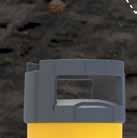







aecimining.com































































































































































 By the Junior Mining Council’s Dr Andries van der Linde PhD (UH, UK)
By the Junior Mining Council’s Dr Andries van der Linde PhD (UH, UK)























 By Levi Letsoko
By Levi Letsoko














































 By Rodney Weidemann
By Rodney Weidemann


































































































































































































